Airasia X fly to Osaka from November 2011 23 Aug 2011 6:33 PM (13 years ago)

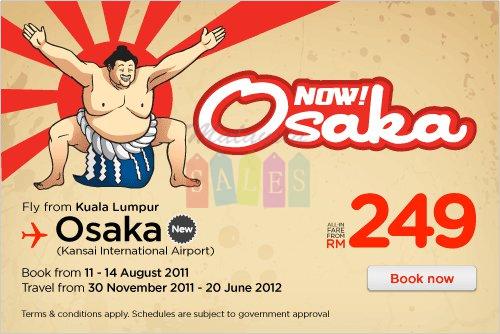
Airasia X, the long haul low-cost affiliate of AirAsia, will begin flying to Osaka, its second destination in Japan after Tokyo from Nov 30, 2011.
The airline will fly direct from Kuala Lumpur to Kansai International Airport in Osaka from 30 November 2011 onwards with four non-stop weekly services.
The Osaka service will be operated on the Airbus A330-300 aircraft with a configuration of 12 Premium Flat Bed seats and 365 economy seats.
This flight is absolutely a good news for tourist who has a big desire to explore Japan but limited in budget. Airasia X has been known for its low cost flight.
Why choose Osaka ?
Osaka is Japan third largest city, and has a great combination between the modern skyline and traditional Japan house.
Osaka’s highlights include Osaka Aquarium, the famous shopping and entertainment district of Minami, Osaka Castle and Sumiyoshi Taisha - one of Japan's oldest shrines. The city is also a gateway to historical Kyoto, Japan’s ancient capital renowned for its beautiful temples, shrines and Gion geisha district; and the port city of Kobe, both of which are less than 30 minutes away by train.
Photos of Osaka taken from Airasia Facebook :
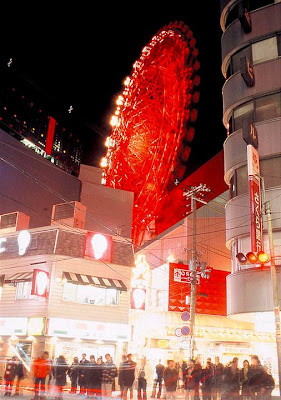





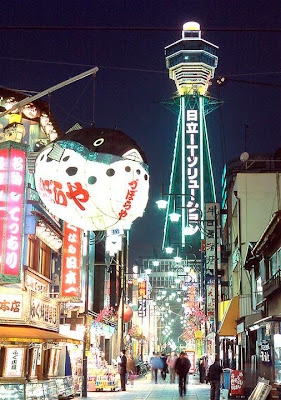


Mount Hakodate Ropeway and Night View 20 Jun 2011 5:36 AM (13 years ago)
 Mount Hakodate, Mount Hakodate ropeway, Mount Hakodate hokkaido, Mount Hakodate japan, Mount Hakodate city, Mount Hakodate view, Mount Hakodate fare, Mount Hakodate access, Mount Hakodate restaurant, Mount Hakodate nightview, Mount Hakodate bus, Mount Hakodate cost,
Mount Hakodate, Mount Hakodate ropeway, Mount Hakodate hokkaido, Mount Hakodate japan, Mount Hakodate city, Mount Hakodate view, Mount Hakodate fare, Mount Hakodate access, Mount Hakodate restaurant, Mount Hakodate nightview, Mount Hakodate bus, Mount Hakodate cost,
Mount Hakodate (函館山) is a mountain in Hakodate, Hokkaido famous for the specatular views from the mountain. Mount Hakodate is a 334 meter high, wooded mountain with a nine kilometer circumference at the southern end of the peninsula on which much of central Hakodate is located. Its location allows an unobstructed view of both the city and the Tsugaru Strait.
Using Mt Hakodate Ropeway (a kind of Gondola) with 125 persons, passenger can view a beautiful Hakodate port and the city streets of Hakodate to Tsugaru Strait an Shimokita Peninsula. When the weather is fine, you can see the Onuma Park and Mt. Komagatake, as well as the Shimokita Peninsula in Aomori Prefecture in the distance.
The night view from the peak is said to be one of the three best in the world with Naples and Hong Kong, and the summer Hakodate Port Festival fireworks, the winter bay area Christmas illumination, and other events provide a beautiful scene of the city being gradually lit up, and it is truly a “million-dollar night view.”
Mount Hakodate nighlife view is also among the best night views in Japan, together with Nagasaki's Mount Inasa and Kobe's Mount Rokko.
Since 1964, Mount Hakodate has been assigned National Reservation for Birds and Animals; there are about 600 species of plants, and about 150 species of animals reside in Mount Hakodate. Also there are the memorial monuments of a zoologist Thomas W. Blakiston, who discovered a distribution limit of Japanese animals in Tsugaru Strait, and a topologist Tadataka Inoh, who published the first surveyed map of Japan. There are souvenir shops, a restaurant with the finest view, and an events hall where 12 monitors produce a multi-vision presentation that introduces the four seasons of Hakodate.
The ropeway to the peak of the mountain departs from the Motomachi District, a 5 minute tram ride from JR Hakodate Station. Alternatively there is a direct bus from the station to the peak during the warm seasons of the year. There is also a hiking course to the top that takes about an hour. The cable car station is about ten minutes walk from "Jujigai" streetcar stop. The Mt. Hakodate Ropeway station is situated near the top of the Nanbuzaka-slope; the Nanbuzaka-slope lies next to the city hall branch office of Suehiro-cho (old Marui-Imai department store). The cable car, which rides 125 people, departs every five minutes in rush time.
Mt Hakodate Ropeway
ACCESS TO MT. HAKODATE
By ropeway
The Hakodateyama Ropeway departs from the Motomachi District. The ropeway's lower station can be reached in a 10 minute walk from the "Jujigai" tram stop (3rd station, 5 minutes, 200 Yen from Hakodate Station) or by direct Hakodate Bus from Hakodate Station (10 minutes, 230 Yen, every 30 minutes in the evening only).
The cost for a ropeway ticket is 1160 Yen for a round trip and 640 Yen for a one way trip. The ropeway operates from 10am to 10pm (until 9pm during winter, from 9am during the Golden Week and summer holidays).
By Bus
From late April to mid November, direct buses by Hakodate Bus operate between Hakodate Station and the summit of Mount Hakodate every evening, taking 30 minutes and costing 360 Yen for the one way journey. Day passes are valid on this bus. There are departures every 20 minutes. Fewer departures in autumn.
By Car
There is a toll free road to the summit of Mount Hakodate. However, the road gets closed to individual car traffic in the evenings between 17:00 and 22:00 from late April to mid October.
Mt. Hakodate Ropeway Fares
Adult : 640yen (One Way), 1,160yen (Round Trip)
Child : 320yen (One Way), 590yen (Round Trip)
Mt. Hakodate Photos :
Mt Hakodate at Day
Mt Hakodate at Night
Mt Hakodate Ropeway
Mt Hakodate Ropeway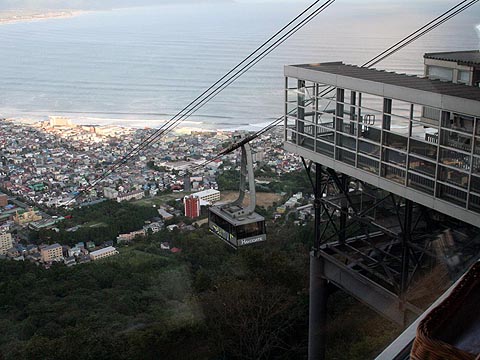
Mt Hakodate Ropeway
Mt Hakodate Souvenir Shop
Mt Hakodate Restaurant Genova
From the top of Mt Hakodate you can see a dreamlike world unlike any other place in the world. The views are spectacular and it is the most comfortable observatory restaurant you'll find at the 2nd floor of the building named "Genova".
Watch Cable car ride up to Mt Hakodate Video here
Shopping at Gotemba Premium Factory Outlet 2 Jun 2011 1:01 AM (13 years ago)
 Visiting Tokyo (or Japan) will not complete without doing some shopping. Tokyo is the world fashion place, and there are also a lot of department stores and shopping centres. Although shopping in Tokyo will damage you a lot of money, but Tokyo is still world well known shopping paradise for its Shibuya, Ginza, Shinjuku, Daikanyama, Harajuku.
Visiting Tokyo (or Japan) will not complete without doing some shopping. Tokyo is the world fashion place, and there are also a lot of department stores and shopping centres. Although shopping in Tokyo will damage you a lot of money, but Tokyo is still world well known shopping paradise for its Shibuya, Ginza, Shinjuku, Daikanyama, Harajuku.
If you want to try something different shopping place and at a cheaper price, then you can visit Gotemba Premium Factory Outlet.
Gotemba Premium Outlet (御殿場プレミアムアトレット)
Gotemba Premium Outlet actually is the most famous popular outlet mall, located in Gotemba City near the foot of Mount Fuji. However, it is quite far from Tokyo central and will take more than 2 hours by train and bus.
Gotemba Premium Outlet is the biggest factory outlet stores in Japan with total area of 350 thousands meter squares, with about 200 outlets stores ranging from international top designer brands to local famous brands.
The goods here are 30%-40% off the normal retail price, if it is during sale seasons, the pricing will fall even to 70% off! By the way, it is very near to Hakone, so you can stop by here after your Hakone trip on the way back to Shinjuku.
Gotemba factory outlet is an upscale outlet mall which housed many international top designer brands like Armani, Balenciaga, Banana Republic, Coach, Dolce & Gabbana, Gucci, Hugo Boss, Kate Spade, Jimmy Choo, Prada, Yves Saint Laurent and many more. But the real good bargains from sportswear brands Nike, Adidas and Puma that will make your trip worthwhile!
Introducing some famous outlet stores in Gotemba Premium Outlets here:
1. Beams Outlet
If you are the Beams fans, you must not miss out the outlet shop here as it is the largest Beams outlet in Japan, it has all brands in Beams Group, the goods sale here are so many and you need to search it slowly, you will definitely get what you want with a very value bargain price.
2. Nike Outlet
The biggest Nike Outlet and has everything about Nike. So you will not miss out any cool gears and clothing if you are Nike fans!
3. Vivienne Westwood
It is not usual to see Vivienne Westwood setup outlet to sell the products, but you will find it here in Gotemba Premium Outlets. It has promotion and discount for old season fashion goods and apply some new arrival promotions for latest season fashions.
How to get Gotemba Factory Outlet
The Gotemba Premium Outlets are located on the outskirts of Gotemba City not far from Hakone. A free shuttle bus operates every 20 minutes between the mall and JR Gotemba Station, stopping at the Tomei-Gotemba IC (interchange or expressway exit) along the way.
There is a free shuttle bus service which operates from 9.30am to 10.40pm at 20 minutes interval. It picks up passengers from JR Gotemba Station (Otome Exit) via Tomei Gotemba Interchange to Gotemba Premium Outlets.
1.From Shinjuku Station
By Bus: At Shinjuku Station West Exit, board the Odakyu Hakone Express Bus to Gotemba Premium Outlets (approx. 100 minutes). Return ticket price: $2800 yen (adult), $2000 yen (kid)
By Bus: At Shinjuku Station’s New South Exit, board Gotemba Premium Outlets Liner (approx. 95 minutes)
By Train: At Shinjuku Station, board the Odakyu Line “Romance Car” Express Train Asagiri (approximately 95 minutes) to reach.
2. From Tokyo Station
By Bus: Tokyo Station’s Yaesu South Exit, board the Gotemba Premium Outlets Liner (approx. 85 min.)
By Bus: Tokyo Station’s Yaesu South Exit (Bus Stop No.1) board the Tomei Highway Bus (approx. 100 min.).
3. From Hakone
At Gora Station board the bus to Hakone Sengokubara (approx. 30 min.). At ?board Hakone Sengokubara to Gotemba Premium Outlet.
4. From Yokohama
At Yokohama Station’s Yokomana, East exit, board the Fujikyoko where you can get Gotemba Premium Outlets Yokohama Shopping Bus Tour. (approx. 90mins)
Gotemba Premium Factory Outlet



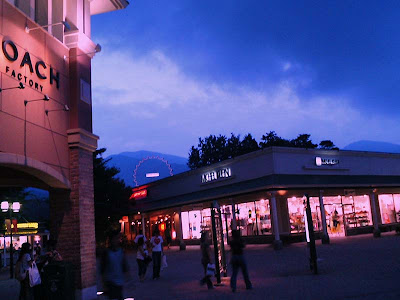



Watch Shopping at Gotemba Premium Factory Outlet Video here
8.8 Earthquake and Tsunami hits Sendai and Tokyo 11 Mar 2011 7:34 AM (14 years ago)
 A big earthquake followed with deadly Tsunami has just rock Japan, especially at Sendai, Honshu Island on March 11th 2011. The biggest earthquake, 8.9 magnitude, to hit Japan in 140 years struck Friday, triggering a 10-metre tsunami that pounded the country’s east coast and prompted advisories along Canada’s West Coast.
A big earthquake followed with deadly Tsunami has just rock Japan, especially at Sendai, Honshu Island on March 11th 2011. The biggest earthquake, 8.9 magnitude, to hit Japan in 140 years struck Friday, triggering a 10-metre tsunami that pounded the country’s east coast and prompted advisories along Canada’s West Coast.
A 10-meter tsunami was observed at Sendai airport in Miyagi prefecture, which has been flooded, with waves sweeping along cars and buildings as they traveled inland.
Bullet train services to northern Japan were halted, rapid transit services in Tokyo were suspended and some nuclear power plants automatically shut themselves down.
Prime Minister Naoto Kan believed that there had been no radiation leaks to the best of his knowledge and in a televised address, he extended his sympathy to the victims of the disaster and said an emergency response headquarters had been set up.
Tsunami warning soon be released to more than 20 countries including Indonesia, Australia, New Zealand, and Taiwan. Don't play and estimate the Tsunami hits. Still fresh in our mind a massive Tsunami crashed Aceh, Indonesia last 2004 and killed more than 100.000 peoples.
How many victims in Sendai Tsunami ?
Hundreds were believed to be dead following the disaster, and the extent of the destruction along a lengthy stretch of Japan’s coastline suggested the toll could rise significantly.
The Red Cross in Geneva said the wall of water was higher than some Pacific islands and a tsunami warning was issued for almost the entire Pacific basin.
Another unnerving report was that the Japanese government had ordered the evacuation affecting 2,000 residents near a nuclear plant in Fukushima.
Earlier the government declared an atomic power emergency but said no radiation leaks were detected among its reactors. The plant had shut down but a reactor cooling system failure had led to the evacuation order.
The quake was the biggest since records began 140 years ago, according to the Japan Meteorological Agency. It surpasses the Great Kanto quake of Sept. 1, 1923, which had a magnitude of 7.9 and killed more than 140,000 people in the Tokyo area.
The 1995 Kobe quake caused $100 billion in damage and was the most expensive natural disaster in history. Economic damage from the 2004 Indian Ocean tsunami was estimated at about $10 billion.
Sendai and Tokyo Tsunami and Earthquake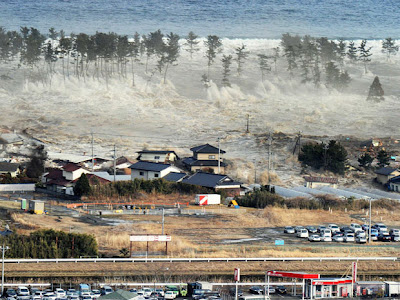





Watch Japan Sendai Tsunami and Earthquake at (March 11, 2011) Video here
Kabuchiko Tokyo Red Light District at Shinjuku 5 Mar 2011 11:50 PM (14 years ago)
 Everyone who goes to Tokyo must not miss Shinjuku. As well as Shibuya, Shinjuku is very identic with Tokyo, famous for its skycrapers and high building. Shinjuku is a paradise for shoppers. It has more department stores than anywhere else in Japan. The most famous are Takashimaya-Times Square, Isetan, Mitsukoshi, Marui, My City and Odakyū.
Everyone who goes to Tokyo must not miss Shinjuku. As well as Shibuya, Shinjuku is very identic with Tokyo, famous for its skycrapers and high building. Shinjuku is a paradise for shoppers. It has more department stores than anywhere else in Japan. The most famous are Takashimaya-Times Square, Isetan, Mitsukoshi, Marui, My City and Odakyū.
The Shinjuku station is one of the most important junctions in the whole transport system: it is estimated more than 2 millions people travel by the three underground lines, the two private urban railways and the JR railways each day.
Big electronics shops are only more numerous in Akihabara. But Shinjuku boasts the biggest of them, such as Yodobashi Camera and Bic Camera.
Music lovers will find their happiness at Tower Records. Note that the Shinjuku branch of HMV closed in January 2010.
Shinjuku Red light District Kabukichō 歌舞伎町
Kabukichō (歌舞伎町?) is an entertainment and red-light district in north east Shinjuku beyond Yasukuni-dōri Avenue. For those who want to seek a night life pleasure or just to have a drinking establishments, then Kabukicho is a must.
Kabukichō is the location of many hostess bars, host bars, love hotels, shops, restaurants, and nightclubs, and is often called the "Sleepless Town" (眠らない街). The district's name comes from late-1940s plans to build a kabuki theater: although the theater was never built, the name stuck.
It is Shinjuku's entertainment district par excellence and one of the hottest places in Tokyo, with hostess bars, adult video shops, soap lands (massage parlours), strip bars and love hotels.
Kabukicho is very famous for its hostess bars, make it Tokyo most famous bars besides at Ginza, Roppongi, and Akasaka.
Kabukicho Photos :
Kabukicho Bar
Kabukicho DVD Shop
Hostess Club
Kabukicho Red Light District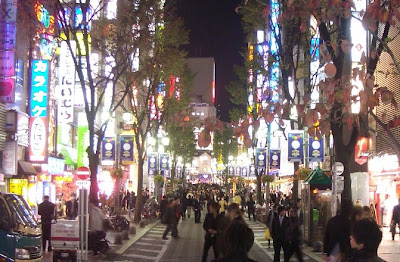
Kabukicho Street
Watch Kabuchiko Red Light District at Tokyo, Japan Video here
Miyazaki famous beach and resort at Kyushu 10 Feb 2011 5:17 AM (14 years ago)
 Miyazaki (宮崎市) is the capital city of Miyazaki Prefecture, located on Kyushu Island. Different with another regions in Japan, Miyazaki has a good climate. With one of the warmest climates on the main islands of Japan combined with attractions such as resorts, beaches and sports facilities.
Miyazaki (宮崎市) is the capital city of Miyazaki Prefecture, located on Kyushu Island. Different with another regions in Japan, Miyazaki has a good climate. With one of the warmest climates on the main islands of Japan combined with attractions such as resorts, beaches and sports facilities.
Tourism has been focused on in Miyazaki City, utilizing its southern-island atmosphere, centered on the Phoenix Seagaia Resort: a total activity facility housing hotels, golf courses, and hot springs.
Miyazaki City is also near attractions such as Takachiho to the north and Kirishima to the southwest, which are both important sites of Japanese mythology and beautiful places to enjoy nature.
Miyazaki Downtown
Visiting Miyazaki means visiting its beach. Miyazaki has so many beautiful beaches, some of them are Aoshima Beach, Sun Beach Hitotsuba, Shirahama Beach, Urashiro Beach, Kumanoe Beach, Sumie Beach, Odotsu Beach, Isegahama Beach.
Miyazaki Attractions and things to do
1. Miyazaki Shrine & Environs
The most important shrine in town is Miyazaki Shrine (Miyazaki Jingu), 2-4-1 Jingu (tel. 0985/27-4004), located about a 10-minute walk west of JR Miyazaki Jingu Station. It's dedicated to the first emperor of Japan, Emperor Jimmu, a somewhat mythical figure who established the Yamato Court in 660 B.C. and is believed to be the ancestor of every reigning emperor since.
2. Heiwadai Park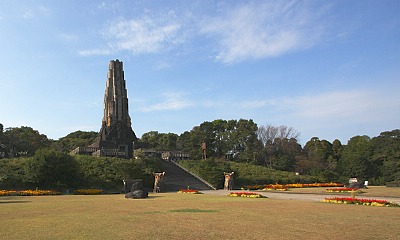
About a 15-minute walk northwest of Miyazaki Shrine is Heiwadai Park, where you'll find the Peace Tower, built in 1940 in celebration of the 2,600th anniversary of the mythological foundation of Japan; it purportedly contains artifacts that once belonged to the first emperor.
3 Haniwa Garden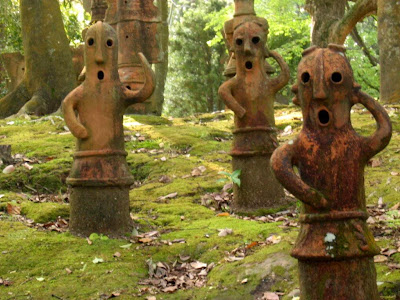
At the far end of Heiwadai park is the Haniwa Garden, a collection of over 400 replica haniwa (burial statues) depicting animals, warriors, dancers, boats and houses arranged along a walking path through the trees. During the Kofun Period these clay statues were placed around burial mounds in tribute to the deceased.
4. Aoshima Island
Aoshima Island is a small, beautiful island just off of the coast of the resort beaches south of Miyazaki City. Aoshima is connected to the mainland by a bridge and is ringed by white beaches surrounding a subtropical jungle at the island's center.
5. Seagaia Resort

The Phoenix Seagaia Resort is the World's Largest Indoor Water Park. It is a massive ocean side resort spanning nearly 10 kilometers of coastline just north of central Miyazaki City. More than just a collection of hotels, Seagaia is a symbol of Miyazaki's resort heritage and offers its guests a wealth of things to do.
6. Miyazaki Prefectural Museum of Nature and History (Miyazaki-ken Sogo Hakubutsukan)
7. Miyazaki Prefectural Art Museum (Miyazaki-kenritsu Bijutsukan)
Miyazaki Photos :
Miyazaki Shrine. This shrine is located in a cave on a cliff next to the ocean. People come here to pray for long and happy marriages, easy childbirth, healthy children, and safety at sea.
Miyazaki Map
Watch Aoshima Island (青島) at Miyazaki, Kyushu Island, Japan Video here
Aoshima Island is located in the south east of Kyūshū and is well known for it's natural coastline (devil's washboard) and it's Shrine, hidden in the jungle.
Kirishima Volcanic Mountain Park at Kyushu 10 Jan 2011 6:42 PM (14 years ago)
 Kirishima, Kirishima national park, mt kirishima, mt takachiho, mt shinmoi, mt karakuni, kirishima yaku national park, ebino kogen, kirishima onsen, kirishima shrine, Kirishima open air museum, Kirishima kyushu, Kirishima travel, Kirishima japan
Kirishima, Kirishima national park, mt kirishima, mt takachiho, mt shinmoi, mt karakuni, kirishima yaku national park, ebino kogen, kirishima onsen, kirishima shrine, Kirishima open air museum, Kirishima kyushu, Kirishima travel, Kirishima japan
Kirishima (霧島市) is a city in Kogashima, Japan, famous for its volcano mountain range between Miyazaki and Kagoshim Prefectures. Kirishima is located on the main island of Kyushu.
Kirishima is famous for its National Park (Kirishima-Yaku National Park), and volcano hiking. So many mountains found at Kirishima especially Mt. Takachiho, the best mount to hike. Other mounts are Mt. Shinmoi, Mt. Karakuni.
Kirishima-Yaku National Park
Kirishima National Park
Kirishima-Yaku National Park (霧島屋久国立公園) composed of two parts : Kirishima and Yakushima.
Located in the southern part of Kyushu, this park embraces Kirishima volcanic range, Kagoshima Bay with active volcano of Sakurajima, and Yakushima Island.
Kirishima Range consists of some 23 volcanic cones with 15 craters in complete shape, 10 of which are filled with water. They present a mysterious sight as if we are visiting the surface of the moon. There are many hot springs at the foot of the mountains where holidaymakers enjoy excursions throughout the year. Hiking and camping are popular in summer, and skating in winter.
Mt. Kirishima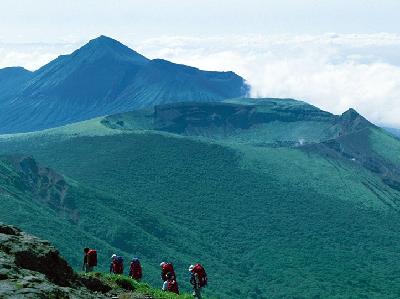
Mt. Kirishima
Mt. Kirishima (Kirishima Volcano) is a Quaternary composite volcano located in southern Kyushu, Japan. It is situated on the southern rims of the Kakuto and Kobayashi calderas. This volcano contains more than 20 small volcanoes which have been repeatedly active from Pleistocene to Recent. Kirishima Volcano is d ivided into two groups, i. e., the Older Kirishima Volcano and the Younger Kir ishima Volcano.
The Older Kirishima Volcano products are now only exposed in t he western foot of the Kirishima Volcano, however, these volcanics predominant ly underlie the present Kirishima Volcano. The activity of the Younger Kirishi ma Volcano began at about 300,000 years ago and continued until the present. M any small stratovolcanoes, polygenetic pyroclastic cones and monogenetic maars and lava flows were formed by the activity. Most of the rocks of Kirishima Vo lcano are composed of augite - hypersthene andesite, with or without olivine p henocrysts. More than 10 eruptive episodes have been recorded in ancient lite rature since A.D.742. Most of documented activities were weak eruptions, howev er, activities in 788, 1235 and 1716-17 were large eruptions and caused great disasters.
Kirishima Main attractions
1. Hiking the volcano
Kirishima Hiking Mount Takachiho no mine
There are a variety of hikes that you can do, but one of the best places to hike in Kirishima is Mt. Takachiho, 1574m, because of its magnificent scenery and views - Sakurajima is visible on a clear day. In order to reach the top of Takachicho, you must climb to the top of Mt. Ochahi and hike around the crater lake, which is 2-3 meters deep and has a stunning color.
2. Ebino Kogen
Ebino Kogen is a small town in the mountains of Kirishima just inside Miyazaki Prefecture's borders. Ebino Kogen means "shrimp highlands" and is so named because in late summer the pampas grass that blankets the ground takes on a pinkish hue from iron in the soil, making the area appear to be covered in fields of shrimp.
3. Kirishima Onsen
Kirishima Onsen
Kirishima Onsen lies on the lower slopes of the Kirishima Mountains with a distant view over Kagoshima Bay and Sakurajima below. The area is made up of over a dozen hot springs, of which the largest and best know is Maruo Onsen. With its high concentration of hotels and central location, Maruo Onsen is the representative resort town of the entire Kirishima Onsen area.
The hot spring towns around Kirishima Onsen are dotted with ryokan and hotels of various sizes. Their many hot spring sources appear at every turn, each billowing clouds of steam from what look like large smoke stacks.
4. Kirishima Shrine
Kirishima Shrine
The mountains of Kirishima are an important site in the creation mythology of Japan. It was in this area that the god Ninigi no Mikoto, grandson of the sun goddess Amaterasu, is said to have descended from heaven to rule over the earth.
There are plenty of nice shrines to see in Kirishima, but the most beautiful and most significant is Kirishima-jingu. In 1989, this shrine was deemed a cultural asset to the nation. Not only is it a large, beautiful shrine, but it also has a rich history. According to ancient texts, the first shrine was built in 1460, between Mt. Takachiho and Mt. Ohara, but was destroyed by a volcanic eruption.
5. Kirishima Open Air Museum
Kirishima Open Air Museum
The museum is a large-scale, open-air museum, which utilizes landscapes and forest space in its outdoor sculpture exhibitions. It is a modern art museum that displays all original pieces from Japanese and foreign artists who visited the space and created works with cultural and/or historical significance.
6. Shinwa-no-Sato Park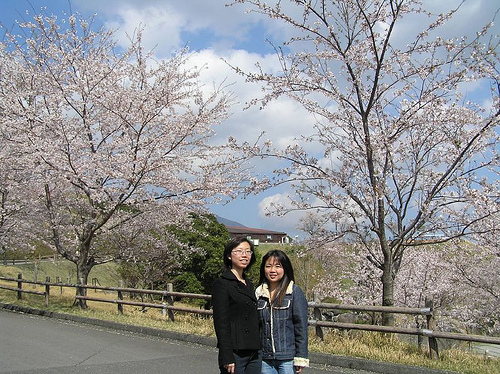
Kirishima Shinwa no Sato Park
This park is a great place to go with a family, as it has a wide array of activities for people of all ages. You can partake in grass skiing, which costs 1000 yen/hour for adults and 6000 yen/hour for students, or take a lift to the top of the hill and take a ride down the massive slides. The Super Slider costs 400 yen/slide (including lift fee) and the Fancy Slider (40m) is also 400 yen/slide. There is also an 18-hole miniature golf course (800 yen/ a round) and a Children's Play Area.
How to get Kirishima
Kirishima is approximately 1–2 hours drive from Kagoshima city, 45 minute drive from Kagoshima Airport
Access to the trailheads at Ebino Kogen (えびの高原) is harder, and your own car will come in handy. Bus schedules change rapidly, but as of 2009, the two options are:
- From Kirishima Jingu, there are two buses on Sat/Sun only (and daily in May) to Ebino Kogen, taking about 1 hour (¥740). Departures are at 8 and 10:20 AM, returning at 1 and 3:30 PM; check with the Kirishima Tourism Office (tel. 0995-57-1588) [2] for updates.
- From Miyazaki's Miyakoh City bus terminal (宮交シティ), Miyazaki Kotsu [3] operates one bus on Sat/Sun (dep 8:41) plus one on Sun only (dep 10:21) that goes directly to Ebino Kogen via Kobayashi. 2.5 hours, ¥2800, April-late Nov only.
Kirishima Royal Hotel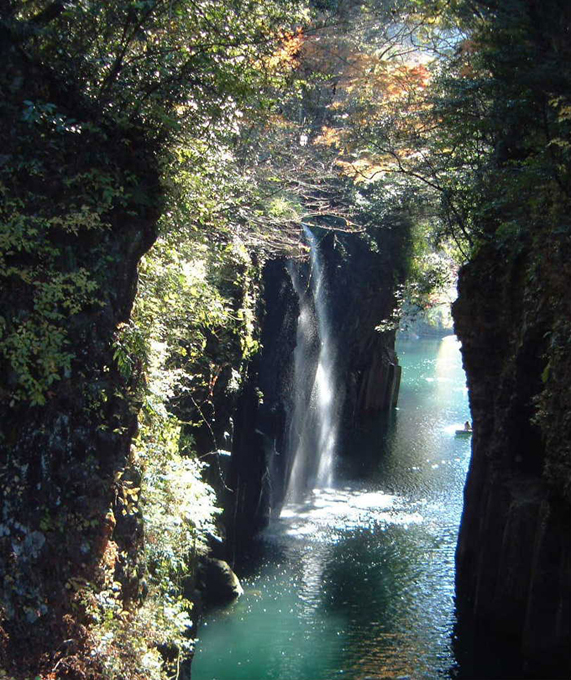
Kirishima Takachiho
Watch Ebino Kogen small towns in Kirishima Video here
Rusutsu Ski Resort at Hokkaido 9 Dec 2010 7:10 PM (14 years ago)
 Rusutsu (留寿都村) is just a small village located in Abuta District, Shiribeshi, Hokkaido. What make Rusutsu popular is for its Ski Resort. As another places in Hokkaido who has a beautiful scenery, Rusutsu ski resort is located 90 minutes by road from Sapporo's International Airport and one hour from Niseko.
Rusutsu (留寿都村) is just a small village located in Abuta District, Shiribeshi, Hokkaido. What make Rusutsu popular is for its Ski Resort. As another places in Hokkaido who has a beautiful scenery, Rusutsu ski resort is located 90 minutes by road from Sapporo's International Airport and one hour from Niseko.
Rusutsu Ski Resort is Hokkaido's largest Ski area in the winter. The area also has an amusement park or golf field to play golf during the summer.
From the top of Mt Isola you can see Lake Toya with the Pacific Ocean in the distance. Rusutsu is a family-friendly resort offering superb ski terrain and excellent facilities.
A large hotel complex sits at the center of the resort, consisting of the highrise Rusutsu Tower, the North and South Wings, the Highland Lodge and several trailside log cabins. A monorail connects the buildings with each other. A few independently run pensions can also be found in the nearby town center of Rusutsu.
Besides skiing, Rusutsu Resort offers numerous other attractions, including restaurants and shops, pool facilities and hot spring baths, as well as places catering to foreigners such as the Cricket Pub sports bar. Summer activities include golf and an amusement park with over 60 attractions and 8 roller coasters.
Rusutsu has 3 main mountains - East, West and Mt Isola. They offer amazing variety and some awesome natural terrain features not found in other resorts. The backcountry is superb, with just a 20 minute hike you can access long steep chutes or a myriad of tree runs. There's also night skiing till 8pm. Add to this one of the best half-pipes and snow-parks in the area and you have a resort which offers everything that the other resorts offer without having to share.
The famous hotel is Rusutsu Resort Hotel. The Hotel offers 761 rooms and resort-scale facilities on top, including dozens of shops and restaurants. Alternatively, you have the option of staying in log cabins, imported from Canada, using timber first imported from Finland.
Rusutsu Ski Resort Photos :
Rusutsu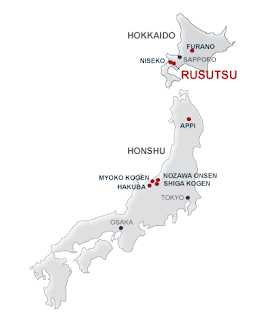
Rusutsu Map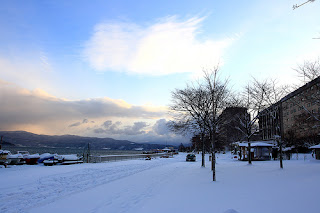
Rusutsu is located close to Lake Toya (Toyako) and is just on the other side of Mount Yotei from Niseko.
Rusutsu Resort hotel. Located at the base of the West Mountain the Rusutsu Resort Hotel offers ski in/ski out luxury accommodation.
Rusutsu Tower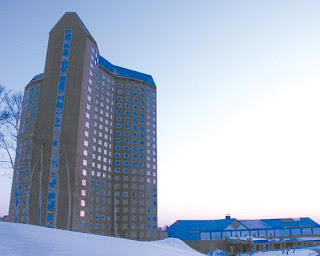

Rusutsu West Mountain seen from East Mountain
Rusutsu Ski
Watch Rusutsu Resort Hotel Video here
Sounkyo Hot Spring and Waterfalls at Hokkaido 5 Nov 2010 8:54 PM (14 years ago)
 Sounkyo (層雲峡) is a hot spring located in Daisetsuzan National Park, Kamikawa, Hokkaido, Japan. it is one of the best hot spring resorts in central Hokkaido visited by 3 million people every year. It is located halfway up the Sounkyo, a mountain with precipitous cliffs continuing for 24 kilometers, and offers visitors breathtaking scenic attractions such as dynamic columnar joints and famous waterfalls including Ginga-no-taki and Ryusei-no-taki.
Sounkyo (層雲峡) is a hot spring located in Daisetsuzan National Park, Kamikawa, Hokkaido, Japan. it is one of the best hot spring resorts in central Hokkaido visited by 3 million people every year. It is located halfway up the Sounkyo, a mountain with precipitous cliffs continuing for 24 kilometers, and offers visitors breathtaking scenic attractions such as dynamic columnar joints and famous waterfalls including Ginga-no-taki and Ryusei-no-taki.
Sounkyo Gorge is situated at the foot of Mt. Daisetsu-zan, which is called the "roof of Hokkaido." The giant gorge, bordered by 100-meter-high cliffs formed by the erosion of tuff, stretches for 24 kilometers and forms the center of Daisetsu-zan National Park. The hot spring area boasts of magnificent scenery and plentiful natural hot water, and attracts three million visitors a year.
The gorge contains lots of waterfalls, of which the Ryusei-no-taki Falls (shooting star falls) and Ginga-no-taki Falls (Milky Way falls) are especially worth seeing. At both of these waterfalls, the water falls directly over the cliff, giving them a sense of great power. The Obako and Kobako rock formations are said to be the most beautiful places in the gorge. Obako features wide rock faces that resemble 'byobu' (folding screens), while Kobako has many fantastic crags. You can rent bicycles there.
If you change from the Daisetsu-zan Soun-kyo Ropeway to the Kuro-dake Lift, you can climb to a height of 1,700 meters and enjoy a magnificent view of Mt. Daisetsu-zan. The Soun-kyo-onsen Hot Spring is in the middle of the gorge, and is full of modern hotels. In summer the Soun-kyo Hi-matsuri (fire festival) takes place in the gorge, while in mid-winter there is the Hyobaku-matsuri Festival (ice waterfall festival).
Every year from the end of January to March, the Hyobaku Matsuri (Frozen Falls Festival) is held where ice pillars and domes placed along the Ishikari River are illuminated in many colors, enveloping the entire area in a magical atmosphere.
Sounkyo Hot Spring
Sounkyo Hotspring Kurodake No Yu
There are so many hot spring places in Sounkyo, as well as the Ryokan. Ryokan is Japanese style inns found throughout the country, especially in hot spring resorts
Sounkyo Hot Spring or Sounkyo Onsen. The famous Hot Spring is Kurodake-no-Yu (黒岳の湯). Kurodake no Yu is a public bath house, located in the town center, it offers indoor and outdoor baths with limited views of the surrounding landscape.
Sounkyo Tourism
Like another parts in Hokkaido, Sounkyo offers a beautiful natural scenery like gorges, waterfalls, and rock formations (obako). Sounkyo Onsen is known and named after the nearby gorge, which runs for 24 kilometers along the Ishikari River and features some pretty waterfalls and interesting lava formations.
Down in the valley, three kilometers from Sounkyo, there are two beautiful waterfalls, Ginga no Taki and Ryusei no Taki, which can be viewed from a large parking lot or from a small observation deck reached via a steep walking trail in about 15-20 minutes from the parking lot. Another five kilometers up the valley is the Obako rock formation.
Tourist attractions at Sounkyo :
1. Ginga no Taki (銀河の滝 waterfall of the galaxy), is a series of thin, silvery rivulets cascading down the mountainside.
Sounkyo Waterfall Ginga no Taki
2. Ryusei no Taki (流星の滝 waterfall of the falling star), is a powerful fall seemingly bursting out of solid rock.
Sounkyo Waterfall Ryusei no Taki
3. The Daisetsuzan Sōunkyō Kurodake Ropeway is on the slope of the gorge, and tourists can get the ropeway and chairlift to climb the mountain.
4. The Sōunkyō Visitor Center is near the resorts and houses picture panels displaying the scenes of Sōunkyō and guides for visitors.
5. Yuyurin Nature Trail. 
Sounkyo Yururin Nature Trail
This trail is a barrier-free sloped wooden path that can be easily navigated by wheelchairs. The car park is made of tree bark, so your shoes will not get muddy on wet days.
6. Asahiyama Zoo. Japan’s popular northernmost zoo
Sounkyo Festival :
1. Sounkyo Hyoubaku Matsuri (Ice Waterfall Festival)
Sounkyo Hyoubaku Matsuri
Ten thousand square meters of river flatlands by the Ishikari River are utilized to display this pageant of ice pillars, ice tunnels, ice domes, etc. The main lookout tower reaches 15 meters, and the view from it at night is mysterious indeed. Saturdays and Sundays have a fireworks display to light up the winter night.
2. Sounkyo Hana Monogatari
Sounkyo Hana Monogatari
This is the first time in Hokkaido where a spa area has coordinated its gardening at the administrative level. We have done things like make large flower beds in public spaces, put up planters and flower baskets in shops and hotels, and coodinated other flower arrangements and themes for the whole Sounkyo region.
How to get Sounkyo :
From Tokyo:
1h 35 min from Haneda to Asahikawa Airport.
From Osaka:
2h from Kansai International Airport to Asahikawa Airport.
From Sapporo:
1h 25 min to Asahikawa Station by JR Hakodate Line (limited express), and 1h 50 min from Asahikawa Station to Soun Gorge by JR bus.
Sounkyo Photos : 
Sounkyo Kurodake Ropeaway
Sounkyo Hot Spring
Sounkyo Hot Spring
Sounkyo Rock Formation Obako
Watch Daisetsuzan Sounkyo Kurodake Ropeway Video here
The Daisetsuzan Sōunkyō Kurodake Ropeway is a Japanese aerial lift line in Kamikawa, Hokkaidō, operated by Rinyū Kankō.
Scuba diving at Izu Peninsula Japan 7 Oct 2010 8:39 PM (14 years ago)
 Boring with culture and historical sites from Japan ? Try heading underwater. Japan may be not the best diving in the Asia like in Thailand or Maldives. But don't forget Japan is a country full of island, a narrow archipelago with 34,000 kilometers of coastline and more than 2,000 diving points.
Boring with culture and historical sites from Japan ? Try heading underwater. Japan may be not the best diving in the Asia like in Thailand or Maldives. But don't forget Japan is a country full of island, a narrow archipelago with 34,000 kilometers of coastline and more than 2,000 diving points.
Saying diving in Japan, this place should be the best : Izu Peninsula. Izu Peninsula is the best choice for diving in Japan, as well as Ogasawara Islands, Hokkaido and Northern Japan, and Okinawa.
Izu Peninsula (伊豆半島 - Izu Hanto) located in Shizuoka Prefecture, is only an hour by train from central Tokyo. It includes both Japan's first dive spot - Izu Oceanic Park, on the east coast - and the best on the main island of Honshu - Osezaki, on the west coast.
How to get Izu Peninsula
The shinkansen links Tokyo to Atami in about 50min (around ¥3,600). Regular trains make the trip in about 1h40min and cost ¥1,890.
Several train lines (Shinkansen, JR Superview, JR Ito, Izu Kyuko...) link Izu's towns. As times and fares depend on the line and connections, you had better check Yahoo Transit or Ekitan from our Transportation in Japan page for exact fares and timetables.
Izu Peninsula main attractions :
1. Atami 熱海市
Atami is a city located in the eastern end of Shizuoka, Japan. Atami is a hot spring city with shinkansen station at the entrance to the Izu Peninsula. While the city is attractively located on the steep slopes along the ocean coast, it has obviously suffered from the economic downturn of the 1990s.
2. Ito 伊東市
Ito is a city located on the eastern shore of the Izu Peninsula in Shizuoka, Japan. Ito is another hot spring city along the peninsula's eastern coast, only about 15 kilometers south of Atami. Inside Ito's municipal limits lies Izu Kogen, a pleasant resort town with more hot springs and the nearby scenic Jogasaki coast.
3. Shimoda 下田.
Probably the most pleasant town to stay in the peninsula, Shimoda is also the most interesting historically. The Shimoda Hot Spring is the collective name of the hot springs (Rendaiji, Kawachi, Shirahama, and Kannon Hot Springs) in Shimoda City, the closest resort area from the heart of Tokyo located in the southeastern port town of the Izu Peninsula.
This is where Commodore Perry and his Black Ships first came to Japan to negotiate the country opening of its port to US ships. In 1854, the the Shogunate and the US signed a Treaty of peace and amity, which effectively ended Japan's 250 years of self-imposed isolation.
Consequently, Shimoda was, along with Hakodate, the first port open to Western ships. The first American consul, Harris Townsend, established his consulate in Shimoda in 1856.
Best Time to Visit Izu Peninsula
Diving at Izu is done year-round, but conditions are highly variable. In summer and early autumn, water temperature may reach the low 80s, underwater visibility is typically 15 to 30 feet and popular dive sites can be extremely crowded. In winter, water temperature may drop to the mid-50s, visibility increases to 40 to 80 feet (even more at offshore islands), but the weather can be less reliable. Dry suits are highly recommended for winter diving at Izu.
Izu Peninsula Scuba Diving info :
- Mar Scuba Tokyo; Phone: +81 (0)90 3851 3901; Email: matt@marscuba.com; Website: http://www.marscuba.com Mar Scuba Tokyo is the longest-running English dive operator in the Tokyo area and offers fun dives and courses at various locations throughout the Izu Peninsula.
- Japan Underwater Explorers; Email: info@jue.jp; Website: http://www.jue.jp J.U.E. is a recreational and technical dive club/service offering multi-lingual training and fun dive adventures. Japan's premier GUE training service.
Izu Peninsula websites :
www.town.oshima.tokyo.jp
www.tokyo-islands.com
Izu Peninsula Photos : 
Located South-West of Tokyo and right South of Mount Fuji, the Izu Peninsula faces the Pacific ocean and is part of the Fuji-Hakone-Izu National Park.




Shimoda Hot Spring. The Shimoda Hot Spring is the collective name of the hot springs (Rendaiji, Kawachi, Shirahama, and Kannon Hot Springs) in Shimoda City.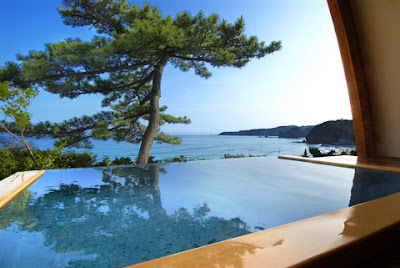
Shimoda Yamatokan. Luxury Spa Vacations in the Izu Peninsula - Shimoda Yamatokan & Seizan Yamato Japanese-style Inns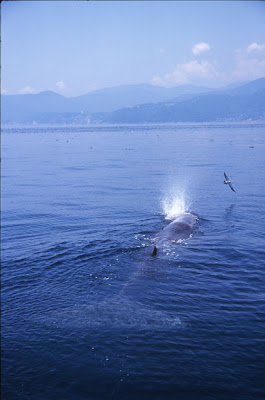
Whale as seen at Izu Peninsula
Watch Izu Peninsula view by train video here
Toyohashi Japan Motor Company Port City 14 Sep 2010 6:51 AM (14 years ago)
 Toyohashi (豊橋市) is a Japan city located in Aichi Prefecture in Honshu Island. Actually, Toyohashi is the center point between Tokyo and Osaka. Toyohashi is famous for its Autmobile Company as The Toyota Motor Company has its productiion facility in the nearby city of Tahara. Toyohashi, formerly called Yoshida, is 70 km south east of Nagoya.
Toyohashi (豊橋市) is a Japan city located in Aichi Prefecture in Honshu Island. Actually, Toyohashi is the center point between Tokyo and Osaka. Toyohashi is famous for its Autmobile Company as The Toyota Motor Company has its productiion facility in the nearby city of Tahara. Toyohashi, formerly called Yoshida, is 70 km south east of Nagoya.
Toyohashi has an important rail hub connecting Aichi, Nagano and Shizuoka Prefectures. With a population about 380.000, Toyohashi is Japan largest port for the export/import of motor vechiles.
Toyohashi Tourism
Toyohashi is a small city, therefore not so many things to see there. Many visitors are more attracted to visit Tokyo, Nagoya, or Osaka.
But nowadays, the popularity of Toyohashi is increasing a lot. The most famous sites including Yoshida Castle, Toyohashi Zoo and Botanical Gardens , and Toyohashi Museum of Natural History.
Many of Toyohashi's places of interest are located near to to Shiyakushomae (City Hall) - a short streetcar ride from Toyohashi Station.
The striking 1930s Romanesque-style Public Hall has become a symbol of the city and is built in an unusual fashion for a civic building in Japan.
The nearby Haristos Orthodox Church (built in 1913) also deserves a mention and it is possible to view the church's impressive icons inside the building. There are also both Catholic and Anglican churches located close to the City Hall.
From there it is a short walk to the pleasant Toyohashi Park and Yoshida Castle on the banks of the Toyokawa River.
Yoshida Castle was first built in 1505 by Makino Kohaku, but all that remains is a corner keep that was restored in 1954. The castle was taken over by the feudal lord Ikeda Terumasu in 1590, who began a grandiose rebuilding scheme, but the castle was never completed. The keep is free to enter and there are good views out over the Toyokawa River. The grounds of the park were used as an Imperial Army barracks during the Meiji period and a Meiji-era sentry box and gate are evidence of that period. Toyohashi Park is also a favored cherry blossom viewing spot in season.
Also in the park are the Sannomaru Kaikan - a tea room for performing the tea ceremony and the Toyohashi City Art Museum, which has exhibits of local history and more modern temporary art exhibitions.
It's possible to walk on the southern banks of the Toyokawa River even as far as the Toyokawa Bridge about 4km in all and then across the bridge to the Maeshiba Tomyodai (Tomeidai) - one of Japan's oldest wooden lighthouses. On the way is Minatomachi Koen, with the pleasant nearby shrine Minatoshinmeisha Shrine.
Another historical building in Toyohashi well worth seeing is the Edo Period Futagawa-juku. This large inn or honjin on the Tokaiko highway was built for lords and high-ranking officials traveling along the route between Kyoto and Edo (modern-day Tokyo). The building has been restored and its possible to visit the garden and rooms where the rich and powerful of the day would stay. There is an adjacent museum with exhibits on the history of the Tokaido.
Tel: 0532 41 8580
The nearest station is Futagawa on the JR Tokaido Main Line.
Across the Toyokawa River are the much older Urigo Ruins where there is a reconstruction of a Yayoi Period (300 BCE - 300 CE) "dug-out" style dwelling.
Toyohashi Museum of Natural History
The Toyohashi Museum of Natural History opened in 1988 to commemorate the 80th anniversary of the establishment of the Toyohashi municipal government.
It was established under the themes of evolution and natural history.
The museum aims to promote better understanding of nature and life by broadening knowledge and deepening familiarity with nature.
Yoshida Castle
Yoshida Castle was originally built by the order of a feudal lord, Kohaku Makino in 1505 under the name of Imahashi Castle. It was occupied by many feudal lords in the Warring States period. The castle name was changed later to Yoshida Castle and Terumasa Ikeda occupied the castle after Hideyoshi Toyotomi had control over all Japan. The castle itself was changed from a middle age castle to a modern castle. Currently, the ruins of the turret remain in the north side of the park near the Toyogawa River. People may see the old image of the castle in the reproduced turret iron tower and engraved rock walls. A Green tea ceremony is served in a standing manner at Sannomaru Kaikan located at the ruins of the Sannomaru Enclosure. Many large old trees are preserved in Toyohashi Park where Yoshida Castle is located, and the park is loved by the citizens as an oasis of nature where you can see wild birds even though it is located in the town area.
Photos of Toyohashi tourism :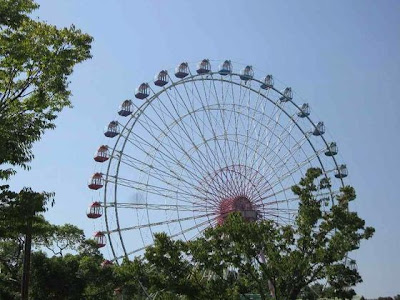
Amusement Park Area in Toyohashi Zoo and Botanical Park. An amusement park area with a roller-coaster, a ferris wheel, 50 meters high, a merry-go-round and even shooting coaster ride.
Toyohashi Museum of Natural History. The Toyohashi Museum of Natural History opened in 1988 to commemorate the 80th anniversary of the establishment of the Toyohashi municipal government.
Toyohashi Downton
Toyohashi Station
Toyohashi Yoshida Castle
Toyohashi Nikko Hotel
Watch Toyohashi Station Video here
Airasia X flight Kuala Lumpur to Tokyo for 14.000 Yen 6 Aug 2010 11:14 PM (14 years ago)



Good news for Japan lovers, especially who residents at South East Asia. The low cost airlines from Malaysia, Airasia, will serve the flight between Kuala Lumpur to Tokyo Haneda airport by the end of 2010. This news is just like dreams comes true for ASEAN visitor, and many passengers will like Airasia as the company will sell one-way tickets between Kuala Lumpur and Tokyo for as low as 14,000 yen.
Operated by AirAsia X, AirAsia's long-distance airline, the flights between Kuala Lumpur International Airport and Tokyo's Haneda airport will begin at a pace of three per week. The flights are expected to use Airbus SAS' A330 aircraft. The Japanese government has already allotted landing and takeoff slots to AirAsia X at Haneda.
The flight will arrive at Tokyo Haneda Airport, and not Narita Airport. Haneda airport is about 14 km (8.7 mi) south of Tokyo Station.
Airasia seems to be more focus with internation flight between South East Asia and East Asia. Recently, Airasia X also launched the new route between Kuala Lumpur to Seoul.
At present, the cheapest round-trip airfares for Japan-Malaysia flights sell for more than 40,000 yen. Saying that the one-way fare for its flights will likely cost less than a cab ride from Tokyo to Narita International Airport, Fernandes expressed his confidence in the service's success.
Tokachigawa Hot Spring Onsen in Hokkaido 6 Jul 2010 8:36 PM (14 years ago)
 Japan is very famous for its hot spring or Onsen. One of the most popular hotspring in Japan is The Tokachigawa hot spring (十勝川温泉), especially in Hokkaido Island. The Tokachigawa Hot Spring is located quite close to Obihiro's urban district and gushes out along the Tokachi River.
Japan is very famous for its hot spring or Onsen. One of the most popular hotspring in Japan is The Tokachigawa hot spring (十勝川温泉), especially in Hokkaido Island. The Tokachigawa Hot Spring is located quite close to Obihiro's urban district and gushes out along the Tokachi River.
Besides Tokachigawa, another hot spring in Hokkaido are Noboribetsu, Yunokawa, Akanko, Kawayu, Utoro, Abashiri, Sounkyo, Asahidake, Jozankei, Asarigawa, Lake Toya.
Tokachigawa Onsen is the best-known and most popular lowland resort in Tokachi. It is located in Otofuke, about 10 kilometres from the centre of Obihiro city, on the north (left) bank of the Tokachi River (Tokachigawa).
Tokachigawa Onsen is a hot spring with mōru baths. The brown-coloured water contains traces of organic material from peat bogs. (The word mōru is a loan word from the German (das Moor) for bog.) Most hotels and inns allow the general public to use their baths.
What’s a “moor hot spring”?
Tokachigawa hot spring is on the Tokachi River in Otofuke Town, in the middle of the Tokachi Plains. The hot spring gushes up through a lignite layer composed of the remnants of reeds and other wild plants that have accumulated over the ages. The moor vegetation makes the water rich in organic components. The waters are milder and richer in natural moisturizers than ordinary hot springs, smoothening and moisturizing the skin and making Tokachigawa hot spring famous as a “hot spring for beauty.”
Tokachigawa Sightseeing
Tokachigawa is not only providing hot springs, but also we can enjoy a natural splendor that’s unique to Hokkaido. Some of Tokachigawa sightseeing such as :
1. Tokachigaoka Park
This park features a vast lawn and fun wooden playground equipment. At its center is a huge flower clock called “Hanack.” Its face is 18 m in diameter, and its second hand is 10.10 m long. For souvenirs and delicious soft-serve ice cream, come to the Welcome Hanack concession stand.
The outdoor cooking area and multipurpose square make this a park that embodies Tokachi’s distinctive magnificence.
2. Tokachigaoka Scenic Viewpoint
This overlook is just up the hill from Tokachigaoka Park. It commands a view of the eternally flowing Tokachi River, the Tokachi hot spring resort, the vast Tokachi Plain, and the faraway Hidaka Mountains. It’s an ideal spot to enjoy lovely sunsets.
3. Swan Viewing Area
4. Footbath
5. Tokachi Farm
6. Row of White Birches
7. Sunflower Fields
8. Ryugetsu Sweetopia Garden
Obihiro and Tokachi are known for confectionery, and Ryugetsu exemplifies the best in the sweets of these areas.
9. Suzuran Park
In early June, pretty lilies of the valley bloom in clusters in this park.
Wild birds, Hokkaido squirrels and other animals live here, and the park is a celebrated cherry-blossom-viewing spot, bustling with visitors every spring.
10. Tokachi Ecology Park
Tokachi Ecology Park was established as a park for environmental education at the Tokachigawa hot spring resort, where forests meet rivers.
Tokachigawa Onsen Daiichi Hotel
Tokachigawa Onsen Daiichi Hotel. Address : 12-1, Minami, Tokachigawa-onsen, Otofuke-cho, Katou-gun, Hokkaido 080-0263, Japan
There are a lot of hotels that provide hot springs in Tokachigawa, one of the best is Tokachigawa Onsen Daiichi Hotel.
Located along the river of Tokachigawa. In front of the hotel, you can enjoy glorious view of Tokachi's nature. Tokachi Hot spring water will make your skin more beautiful, because it contains plenty of natural moisturizing factor. To offer safety food, we are particular about ingredients, which grown up in Hokkaido and Tokachi. We are proud of our speciality and to make you satisfy. Please enjoy Tokachi by delicious meals and Hot springs.
Why choose Tokachigawa Onsen Daiichi Hotel
1. The hotel is embraced by moor springs, one of Hokkaido's heritages, and the great wilderness of Tokachi
The Tokachi region shines with abundant sunshine and rich soil. The Tokachi River nourishes the fertile soil of Tokachi. The gently flowing Tokachi River creates majestic scenery with the backdrop of the Hidaka and Taisetsu mountain ranges. The scenery of Tokachi is deeply embedded in people's minds.
2. Hoshu-tei Traditional Japanese-style Building
Hoshu-tei is a traditional Japanese-style building. The nostalgic fragrance of tatami mats creates a calm, placid atmosphere that fills the building. The beauty of Japan that has been cherished by the Japanese is available here.
Relax physically and mentally in a Japanese atmosphere. Traditional Japanese-style interior with tatami mats and fusuma doors (thick paper sliding doors) that create the placid atmosphere of old Japan. A guestroom with private outdoor bath available only in Hoshu-tei.
Tokachigawa Onsen Daiichi Hotel Address :
Hoshu-Tei, a traditional Japanese building, and Toyo-Tei, a modern Japanese building
12 Minami, Tokachigawa Onsen, Otofuke-cho, Hokkaido, Japan 080-0263
Tel: +81-155-46-2231
Fax: +81-155-46-2238
Photos of Tokachigawa and Tokachi River sightseeing :
Tokachi Ecology Park was established as a park for environmental education at the Tokachigawa hot spring resort, where forests meet rivers.
Tokachi Nature Center. Enjoy the natural grandeur of Tokachi from riding a canoe, hot-air balloon and even paragliding. Experienced instructors show you how. It’s not every day you have a chance to try these thrilling outdoor sports.
Hot Air Ballooning at Ohibiro City. See a vast panorama from 30m (100 feet) in the air: the Tokachi Plains, Tokachi River, the Hidaka mountains and more!
Whooper Swans, Tokachi River, Hokkaido, Japan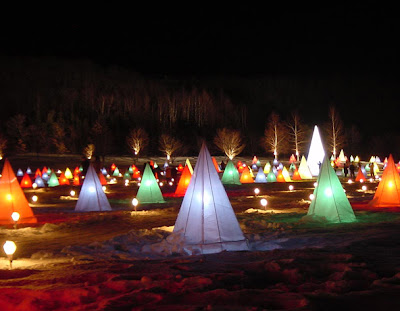
Tokachigawa Hot Spring. This hot springs gushes forth from the ground on the left bank of the Tokachi River in the town of Otofuke, situated in the center of the Tokachi Plain.
Watch Tokachigawa Swan Festival "Sairinka" video
Nagano Yatsugatake Mountains and Royal Hotel 22 Jun 2010 11:03 PM (14 years ago)
 The Yatsugatake Mountains (八ヶ岳) is one of Japan famous mountains located between Nagano Prefecture and Yamanashi Prefecture on the island of Honshū in Japan. Yatsugatake literally means eight mountains. Actually there are more than eight peaks. Japanese word “hachi” (eight) sometimes implies “many”.
The Yatsugatake Mountains (八ヶ岳) is one of Japan famous mountains located between Nagano Prefecture and Yamanashi Prefecture on the island of Honshū in Japan. Yatsugatake literally means eight mountains. Actually there are more than eight peaks. Japanese word “hachi” (eight) sometimes implies “many”.
Yatsugatake is one of Japan most visited mountains besides the trademark Mount Fuji and Tateyama which famous for its ski resort.
The Mt. Yatsugatake mountain range with its main peak Mt. Akadake (2,899m) and the 3,000m Southern Alps with the lofty Mt. Kitadake (3,192.6m) make a magnificent, powerful mountain view. The Mt. Yatsugatake area is one of stunning nature that changes in various ways throughout the seasons and is a symbol of Japan’s highland resorts.
Eight mountains in Mt. Yatsugatake have generally pointed out Mt. Aka (2899m), Mt. Gongen (2715m), Nishitake (2398m), and Mt. Amigasa (2524m) of Mt. Tengu (2646m), Mt. Ioh (2760m), Yokodake (2829m), Mt. Amida (2805m), and a dominant peak. As it seems that the portion to Mt. Tateshina located further here north is also contained when it becomes the Mt. Yatsugatake mountain range.
Kiyosato Highland stretches out across the foot of Mt. Yatsugatake, whose peaks range from an altitude of 800m to 1,500m. There are retreats, the best known being Seisen Ryo, hotels, pensions, art museums, restaurants, and at the night you can gaze out at the night sky full of stars – a sight not seen in urban areas.
How to access Mount Yatsugatake
It takes approximately 2 hours from Shinjuku Station in Tokyo to JR Kobuchizawa Station by train (JR Chuo Line), approximately 2 hours by car to Nagasaka I.C. on the Chuo Expressway, or around 2 hours 30 minutes by Chuo Highway Bus from Shinjuku Station West Exit.
It takes approximately 50 minutes by car or around 1 hour by train from the Mt. Yatsugatake area to the Kofu area.
From the Mt. Yatsugatake area to the Isawa area it takes 1 hour 10 minutes by car or 1 hour 15 minutes by train (Fuji Kyuko Line from Otsuki Station (JR Chuo Line)).
To the Fujikawaguchiko area it takes approximately 1 hour 40 minutes by car or 1 hour 50 minutes by train on the Fuji Kyuko Line from Otsuki Station (JR Chuo Line).
Yatsugatake-Chushin-Kogen Quasi-National Park
This wide park that spans both Yamanashi and Nagano prefectures boasts lakes, white birch trees and alpine plants, all encompassing the Yatsugatake peaks at its center. Kiyosato and other highlands, with their pastoral scenery reminiscent of European landscapes, capture the hearts of their many visitors. Stand at the top of 5,059 ft high Utsukushi-Mori, turn 360 degrees, and take in an incredible view including Mt. Fuji, the Minami Alps and Oku-chichibu.
One of top attractions in Yatsugatake-Chushin-Kogen Quasi National Park is Lake Shirakaba-ko. Lake Shirakaba-ko is an artificial lake that is up to 9 meters deep, and 1,416 meters above sea level. It is located at the western foot of Mt. Tateshina-yama in the northern part of Chino City, Nagano Prefecture, and belongs to Yatsugatake Chushin Kogen Quasi-National Park. Visitors can cruise the lake between Mt. Kuruma-yama and Mt. Tateshina-yama by tour boats or pedal boats. You can also enjoy cycling around the roads along the lakeside, and there are camping grounds and ice skating rinks in the vicinity.
Resort Outlets Yatsugatake
Visit Yatsugatake is not only a mountain views matter, but we can also make a shopping. Yatsugatake is also famous for its shopping mall. Resort Outlets Yatsugatake is a shopping mall surrounded by huge mountains and in harmony with nature.
The vast complex is divided into seven areas and all courts have stunning views of Mt.Yatsugatake and The Southern Alps.
There is a large variety of shops such as those selling designer goods, sports and outdoor goods, everyday items, and there are also restaurants. The mall offers stylish fashion and provides a quality shopping space.
Yatsugatake Royal Hotel
One of the most famous hotel in Mount Yatsugatake is Royal Hotel. Yatsugatake Royal Hotel attracts around 20,000 guests each year. The ideal location offers a wonderful view of Japanese major mountains such as Mt Fuji and Yatsugatake, and night-time star watching at the observatory. With a hot spring resort in the facilites, this is one of the leading resort hotels in the prefecture.
It takes 15 minutes on foot or 3 minutes by taxi from Kai-oizumi Station on JR Koumi Line, which runs from Obuchizawa Station on Chuo Line connecting Shinjuku of Tokyo in 120 minutes. The Kiyosato Village, one of the famous resorts, is 15 minutes by car.
Yatsugatake Mountain Photos
Snow at Yatsugatake Mountain
Yatsugatake Peak
Resort Outlets Yatsugatake is a shopping mall surrounded by huge mountains and in harmony with nature.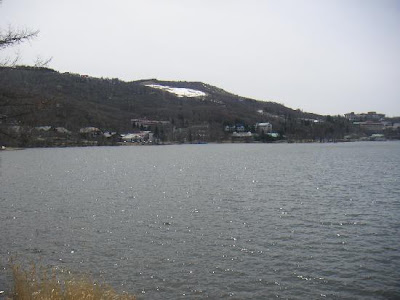
Lake Shirakaba-ko Yatsugatake is an artificial lake that is up to 9 meters deep, and 1,416 meters above sea level.
Yatsugatake Royal Hotel. Three minutes by hotel shuttle bus from Kaioizumi Station of JR Koumi Line (Reservation necessary)
20 minutes by the car or taxi from Kobuchizawa station of JR Chuo Honsen line
Yatsugatake Station Map. By train : 15-minute by taxi from JR Chuo Main Line Chino station. By car : 10-minute from Chuo Express way Suwa-minamiIC
Yatsugatake-Chushin-Kogen Quasi-National Park
At the top of Yatsugatake-Akadake Climbed through the West Wall Mt. Fuji is seen on the left
Watch Climbing at Sansa Hou Runze, Yatsugatake video here
A very cold ascent of the Sansa Hou Runze route on Yatsugatake on the 20th January 2008.
(Climbers - Alan Tomlinson, Rod Szasz, Tony Grant, Dave Puglisi)
Travel from Shanghai to Osaka by Ferry 21 May 2010 9:22 AM (14 years ago)
 Japan may be one of many tourist top destination country, but not everyone can visit Japan because of the high cost and incapable of speaking Japanese. A usual tour service usually charge about 2000-3000 USD for travelling inside Japan cities, but not everyone can pay the high cost only for a 7 days tour.
Japan may be one of many tourist top destination country, but not everyone can visit Japan because of the high cost and incapable of speaking Japanese. A usual tour service usually charge about 2000-3000 USD for travelling inside Japan cities, but not everyone can pay the high cost only for a 7 days tour.
One of alternative way to visit Japan is by ferry from Shanghai. Shanghai, the modern city in China, is the world's third largest port and China's largest seaport. We can use the ferry from Shanghai, cross the East China Sea to Osaka.
'New Jianzhen' is a passenger and cargo ship sailing regularly between Shanghai and Japan. It starts from Shanghai at 13:00 every Saturday, and arrives at Kobe or Osaka Ports of Japan on Monday morning the next week. The ship makes its return voyage from Kobe or Osaka at 12:00 every Tuesday, and it reaches Shanghai on Thursday. The speed of the ship is low, and a round trip usually takes over 80 hours. However there are still many people who choose this liner because of the good environment, excellent service, and low price. A single journey ship passage costs CNY1,300 to CNY2,600 (JPY20,000 to JPY40,000) per person according to the standard of cabin chosen. Alternatively you can pay CNY6,500 (JPY100,000) for a VIP room, which can accommodate two persons. For more information of this liner, you can phone 021-63257642.
'Suzhou' ship also voyages between Shanghai and Osaka in Japan. Starting from Shanghai at 11:00 every Tuesday, it reaches Osaka at 9:00 on Thursday. Every Friday, the ship makes its return at 12:00, and gets to Shanghai on Sunday. The ship passage is almost the same as that of 'New Jianzhen' ship.
When you take an international cruise, you'd better go to the port two hours before departure to conduct the boarding procedures. Ship tickets can be bought or booked at Shanghai International Ferry Co., Ltd. with your passport or other valid identification.
Ticket Office Address: D-G, 15 F, Jin'an Mansion, No.908, East Daming Road, Hongqiao District
Ticket Information Line: 021-65375111
After completion of the whole project, Shanghai Port International Cruise Terminal will have more international passenger liners to facilitate the needs of modern tourism.
How to travel from Shanghai to osaka by Ferry
The Shanghai Ferry Company operates a weekly service between Osaka and the Chinese port city of Shanghai. The journey takes approximately 48 hours. During these 48 hours they offer cheap and best service to their passengers at a very low rate. This ferry is Japan's first largest and modern ferry.
One- way tickets cost between ¥20,000 and ¥50,000. They offer discounts of up to 40% on return fares and 10% discount is given to students is also available.
Ferry runs weekly between Shanghai and Osaka, Japan. The ferry is having restaurants, a game room, and even karaoke on board, that makes your journey more enjoyable. It leaves from Waihongqiao Harbor every Tuesday at 11 AM and arrives in Osaka at 9 AM the following Thursday.
They recently launched a ship from Shanghai's Waihongqiao Harbor every Saturday, alternating between Osaka and Kobe in Japan. The journey takes approximately two days and tickets for this journey can be booked through the company or through CITS.
Tickets for this ferry can be booked through the company or through China International Travel Service (CITS), the government tourism office.
Website for info about Shanghai-Osaka Ferry
http://www.shinganjin.com/index_e.php
The Shanghai Ferry
4-1-2 Minami Kyuhoji-cho, Chuo-ku
541-0058 Osaka
Tel. +81662436345
pax@shanghai-ferry.co.jp
http://www.shanghai-ferry.co.jp

Shanghai to Osaka Map

CHINJIF. Ferry from Shanghai to Osaka Japan
Watch a trip from Shanghai to Osaka Japan ferry video here
Omachi Nagano Ski Resort and Lake 1 Mar 2010 9:31 PM (15 years ago)
 Omachi (大町市) is a city near Nagano, and is located north of Matsumoto city, also located in the Nagano prefecture.
Omachi (大町市) is a city near Nagano, and is located north of Matsumoto city, also located in the Nagano prefecture.
Omachi is famous for its Mount Tsubakuro (Tsubakuro-dake). It forms part of the Hida Mountains and is a peak in the Northern Japanese Alps, elevation 2763 m/9065 ft.
Omachi Tourism
There are not so many tourist acctractions in Omachi, but Lake Kizaki may be a popular seaside resort.
Omachi Ski is a fairly small ski location which is recommended for beginner or amateur skiiers.
Yearly there is a horse race festival held nearby the Omachi Track and Field ground, the exact date of the year that this is held is often random but always in august.
During August you can also witness the Yamabiko Matsuri , a festival held on the main street which involves many companies from around the area. During this fesitval you can watch a parade on the main street held by all involved, buy snacks and drinks or join in yourself with the parade. All parade members receive free drink and food from their sponsors.
In september you can visit Kamado Jinya ( Kamado Shrine ). During this festival you can make a wish to God via a small donation to the shrine it's self, and enjoy fireworks in the nearby playing feild. There are also food and drink stands set up around the shrine grounds, as well as games.
New year is also held around several shrines in Omachi city. No food stands are available at this time, the festivities often involve a large fire which many people gather around.
Omachi Hotspring
This hot spring is by the Kashima River where the melted snow water from the mountains of Kashima-Yarigatake and Jiigatake flows into and is found along the Tateyama Kurobe Alpine Route, one of the major mountain routes in the world. Since 1964, spring water is drawn from the Kuzu Hot Spring in the western part of Omachi City. The hot spring resort is indeed quiet, surrounded by white birch and beech forests. Because the area is one of the leading museum towns in the country, you will find many unique types of museums here. For example, there is the Alps Onsen Hakubutsukan where you can learn about the mechanism of hot spring generation and the history of the hot springs of the North Alps focusing on the Omachi Hot Spring as well as the Sake-no-Hakubutsukan where approximately 300 brands of Japanese sake from all parts of the country are exhibited while a local sake tasting/sales area is also set up.
Ski Resort in Omachi
Tourist usually visit Omachi for Ski resort. There are six ski resorts located in Omachi; Yanaba Ski Resort, Omachi Ski Resort, Jiigatake Ski Resort, Sun Alpina Kashimayari Ski Resort, Sun Alpina Keikyu Aoki-ko Ski Resort, and Yanaba Parallel Ski Resort. Easy access to each of these places together with a spa in the surrounding area make this location attractive and enjoyable resort for both skiing and hot springs.
Omachi Ski Resort Information, including the phone number :
1. Yanaba Ski Resort/ 0261-23-1123
2. Omachi Ski Resort/ 0261-23-1022
3. Jiigatake Ski Resort/ 0261-23-7555
4. Sun Alpina Kashimayari Ski Resort/ 0261-23-1231
5. Sun Alpina Keikyu Aoki-ko Ski Resort/ 0261-23-2391
6. Yanaba Parallel Ski Resort/ 0261-23-1123
Omachi Best Attractions including lake, museum, Dam
1. Nishina Sanko (Nishina Three Lakes).
These are the only natural lakes in the North Alps mountains. The biggest is Lake Aoki-ko. Its depth and transparency reflecting Hakuba's three mountains, make it one of the greatest lakes in the country. Lake Kizaki-ko, located southern-most among the three, is the water sports haven. A number of campsites attract the crowds in summer.
2. Shio-no-michi Hakubutsukan (Salt Road Museum)
The house of the Hirabayashi family is open to the public as a museum. Hirabayashi was a salt wholesaler in the Yedo period(1603-1868).
3. Omachi Alpine Museum
The town of Omachi has developed as a mountainous country. The local mountain culture, nurtured in nature is introduced in this museum. The transformation of mountain-climbing throughout its history is explained from various aspects with a number of interesting materials displayed.
4. Sake-no Hakubutsukan (sake museum)
Sake (rice wine) production in this town depends on its blessed rich and fresh headwaters. Five hundred pieces of tools exhibited in the museum proves that the town's reputation as a sake maker. Furthermore, sake making history and culture are described in easy-to-understand narration.
5. Omachi Kyodo-gangu Hakubutsukan (local toy museum)
A collection of local toys from all over the country, including Omachi local toys, is displayed in this museum. The collection (2,400 pieces) represents the heartwarming, humorous, and simple features of local toys from different areas of Japan.
6. Henry Miller Museum of Art
Henry Miller is famous both as a distinguished writer and as a watercolor painter. His bright and leisurely style and daring touch of his works, are the hallmarks of this American genius of the twentieth century. This is the first museum built in the world which is dedicated to Henry Miller. The gallery contains a hundred and ten pieces of his watercolor paintings and lithographs.
7. Takase Ravine (Takase Dam, Nanakura Dam, Omachi Dam)
Takase Ravine consists of three dams; Takase, Nanakura, and Omachi. Takase Dam is the biggest in scale: 176 meters high and 11.59 million cubic meters.
In autumn, the leaves turn red and yellow, which contrasts with the emerald green of the reservoir, and the visitors enjoy its beauty.
8. Nishina-shinmeigu Shrine
Omachi area has been called "Nishina's hometown" since the ancient days. Nishina-shinmeigu Shrine is a national treasure, that was built in early Yedo period (1603-1868). There are many cedar trees along the path to the shrine. Standing at the end of the path is the sanctuary of the shrine. This is one of the oldest sinmei-zukuri ( a style of roof) in Japan.
Photos of Omachi city
Lake Kizaki Omachi
Nishina Sanko Lakes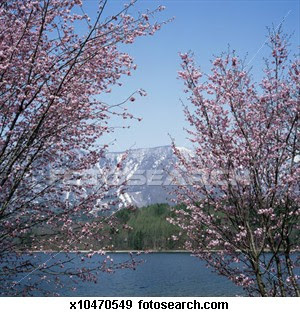
Aoki Lakespring at Omachi City
Kuroyon Royal Hotel at Omachi. Nestled at the foot of Japan's Northern Alps, this luxurious alpine resort hotel is an ideal location to witness the beauty of nature throughout the seasons. After breathing in the crisp mountain air, we're sure you will want to extend your visit in this relaxing, healthy environment.
Omachi Hot Spring view from Kashima River
Watch Nagano Prefecture Omachi City "gigatake"ski area video here
Fukushima Tohoku Lakes and Hot Spring 8 Feb 2010 8:29 PM (15 years ago)

Fukushima City and its surrounding area has many hot springs, which are in Iizaka, Takayu and Tsuchiyu for example. Fukushima is blessed with many natural resources. It has a lot of scenic beauty and various sightseeing places including the Bandai Azuma Skyline. It is one of the biggest tourist resort areas in Tohoku.
The city's location makes it highly accessible from many areas of Japan through a well organized transportation system. From Tokyo, it takes 3.5 hours by the Tohoku Express- way and it takes 1.5 hours by the Tohoku Shinkansen Line. Fukushima Airport was opened in 1993, making it easier for many people to visit the city from not only the metropolitan areas, but also from the Hokkaidou, Kansai,and Kyushu areas.
Fukushima's best known tourist attraction is the former castle town of Aizu-Wakamatsu.
Fukushima is the major tourist spot in Tohoku region. The main attractions including castle, lakes, and hot springs.
Fukushima Location
The city of Fukushima,which is located in the northern part of Fukushima Prefecture,covers an area of 746.43 sq km,stretching 29.9 km from east to west and 38.2 km from north to south. The Fukushima City Hall stands at latitude 37゚45'N and longitude 140゚28'E. Fukushima lies within 300 km of Tokyo.
Some of Fukushima best sightseeeing :
1. Five Colored Lakes (五色沼) are a beautiful attraction visited by many sightseers. The lakes were formed after Mount Bandai (磐梯山) erupted in the 1800's. The minerals from the eruption give each lake a different color.
2. Iwaya-Kannon (岩谷観音) has sixty Buddhas carved into the rock face of Mount Shinobu (信夫山) and offers a decent place to take a look down at the city.
3. Hanamiyama Park (花見山) is the place to go in spring for cherry blossom viewing. It is quickly becoming a place famous throughout Japan, be prepared for crowds. You can take a short trail up a hill and see some amazing panoramas as well as enjoy walking underneath gorgeous light-pink canopies. There are regular buses leaving for Hanamiyama from the train station. Ask the people at the tourist office for more details.
4. Fukushima Small Bird Sanctuary (福島小鳥園) It's a steep walk up a small mountain. The trails at the top are short and quiet. It is very peaceful but not so special.
5. Prefectural Art Museum Small museum mostly with local art, though it does have some national and internal exhibits as well. price varies.
6. Prefectural Culture Center Has different performances year-round.
7. Fukushima Museum. Fukushima Museum
8. Fukushima Racetrack If you feel like betting on horses then this is the place to go in Fukushima. Live races only happen during certain times of the year, but video races are available year-round. It costs ¥100 to get in.¥100.
9. Izaka hot springs
10. Takayu hot springs
11. Tsuchiyu hot springs
12. Shin-Noji hot springs
Fukushima Festival
1. WARAJI MATSURI(Straw Sandal Festival)
This festival on first Friday and first Saturday of August celebrates a huge straw sandal that is dedicated to the Haguro Shrine on February 10.
2. MIZUKAKE MATSURI (Water Throwing Festival)
Starting at Kashima Shrine, this event occurs at the end of the festivities on October 19.
3. SANBIKI SHISHI-MAI (Dance of the Three Lions)
This dance, handed down over generations in the Oonami district, occurs during the Sumiyoshi Shrine festival, October 11-12.
4. AKATSUKI-MAIRI (Visit to the Shrine in the Dawn)
This event occurs on February 10-11. People pray for protection against disasters and for a good harvest. An immense straw sandal is carried up Mt. Shinobu to the Haguro Shrine. The sandal is 12 meters long, weighs 2 tons and 80people carry it.
5. IIZAKA KENKA MATSURI (Fighting Feastival of Iizaka)
During the main festival on October 5, six floats parade through the street and on to the shrine with a portable shrine in the lead.
6. JUUNI KAGURA(The Twelve Sacred Arts)
This annual festival is held at Kuronuma Shinto Shrine in spring. The dancer wears “Kari-ginu”(hunting clothes),“Hakama”(an apron-like skirt), and “Tabi”(socks).
Fukushima Bars and Nightlife
Namazu-tei (なまず停), also known as "Catfish" is a cozy blues bar in Fukushima, which features live music most weekends. Cover charges range from ¥400-500 for the house band "Blues Cruiser" (highly recommended, with a fantastic harmonica player) through to ¥4,000 for more famous acts. Namazu sometimes has a DJ playing, with more of a focus on bossanova and jazz. Johnny the barman speaks passable English, and knows pretty well all there is to know about the Blues, having in his past run "Gangster," a major blues venue in Tokyo.
Neo is the other club in Fukushima. Expect to pay a ¥2000 cover charge and then ¥500 for each drink and to be in a small very smokey room. The music is okay, the crowd is small at best. Expect to feel elderly if you're over 25.
Fukushima Photos and Pictures :
Fukushima city looking east over the Fukushima city train station.
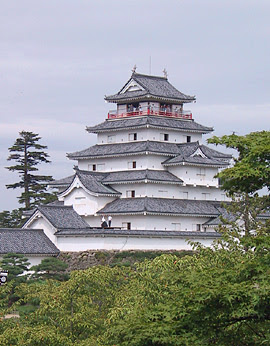
Aizu Tsuruga Castle, Fukushima's best known tourist attraction.

Fukushima Prefectural Museum stands just outside the outer moats of Tsuruga Castle Park. The closest stop of the Aizu Loop Bus is "Tsurugajo Sannomaru" (20 minutes from Aizu-Wakamatsu Station) just outside the museum.
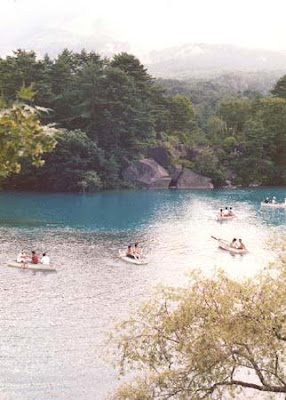
Goshiki-numa or Five Coloured Lake. Goshiki-numa has five marshes, namely Ao-numa, Ruri-numa, Benten-numa, Midoro-numa and Bishamon-numa, each having a water color of its own.
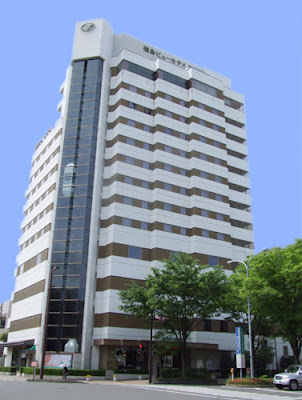
Fukushima View Hotel. Located in front of West Exit of Fukushima Station and surrounded by nature. Japanese restaurant, Chinese restaurant, and French restaurant is available.

Train Station from Sendai to Fukushima
Watch 土湯Tsuchiyu Tunnel (R115, Fukushima City / Inawashiro Town, Fukushima Pref., 3360m) Video here
Saitama Kanto Region Museum and Night Festival 3 Jan 2010 8:33 PM (15 years ago)
 Saitama (さいたま市) is the capital and the most populous city of Saitama Prefecture in Japan. Saitama is the capital of Saitama prefecture in the Kanto region of Japan.It dose not have a coast. It merged from four cities few years ago. Therefore it's the biggest city in Saitama. In addition,it's a the tenth most populous city in Japan.
Saitama (さいたま市) is the capital and the most populous city of Saitama Prefecture in Japan. Saitama is the capital of Saitama prefecture in the Kanto region of Japan.It dose not have a coast. It merged from four cities few years ago. Therefore it's the biggest city in Saitama. In addition,it's a the tenth most populous city in Japan.
Saitama City was born on May 1, 2001, with the merging of the three cities formerly known as Urawa, Omiya and Yono. On April 1, 2003, it became the 13th government designated city in Japan.
Saitama Prefecture is located right north of Tokyo. This prefecture is part of the Greater Tokyo Area, and most of Saitama's southern area can be described as suburbs of Tokyo. Northern area of the prefecture is dedicated for agriculture. The prefecture is also known for richness of cultural craftsmanship. Hina-doll, Japanese paper, carp streamer, and daruma. Some of the famous spots in this area: Hikawa shrine, Chichibu sanja, Hitsujiyama park, and Seibuen park.
Saitama may be famous for its night festival named "The Chichibu-yomatsuri Night Festival". The former castle town of Kawagoe and the mountainous Chichibu region, known for its night festival held in December, are some of the prefecture's major tourist attractions.
Saitama City is not the tourist city. Therefore, not so many natural scenic to see and to do. But there are several park and museum can be the alternative.
Saitama City, which flourished as a post town on the Nakasendo (Nakasendo Road), a shrine town for the Hikawa Shrine and as a castle town with Iwatsuki Castle, has a variety of historical resources as well as unique cultural resources such as Omiya bonsai, Iwatsuki dolls and Urawa unagi eel. It is furthermore home to the Railway Museum, John Lennon Museum and other distinctive facilities found only in Japan and unique in the world.
Some of Visitor attractions in Saitama City :
1. Akigase Park
2. Besshonuma Park
3. Hikawa Shrine
4. John Lennon Museum. A museum located inside the Saitama Super Arena in Chuo-ku, Saitama City, Saitama, Japan. It was established to preserve knowledge of John Lennon's life and musical career.
5. Minuma
6. Railway Museum. A must of rail buffs and great for kids, the museum features 36 engines on display (including Japan's first steam loco), train cab simulators, Japan's largest HO-gauge miniature railway and more.
7. Sonic City
8. Saitama Stadium 2002, a 2002 FIFA World Cup stadium
9. Saitama Super Arena. A multi-configuration arena that can seat up to 37,000 people. Numerous shops, restaurants and attractions can be found within. A pedestrian walkway links the Saitama Shintoshin train station with the Super Arena.It's very big hall.
10. Omiya Bonsai Village. The Bonsai Village, the bonsai mecca, is also well known overseas
11. Iwatsuki Japanese dolls. Japanese dolls are produced in Iwatsuki, which boasts of the highest volume of doll shipments in Japan
How to access Saitama and around :
Terminal Station: Omiya Station(大宮駅)
Access from Tokyo:
-By Train
0.Shinkansen from Tokyo St. to Omiya St. (25 min.)
1.JR Shonanshinjuku Line from Shinjuku St. to Omiya St. (27 min.)
-By Car
Using Shuto Expressway to Shintoshin (1hr.)
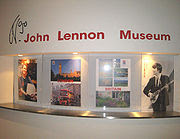
This is the only official John Lennon museum in the world authorized by Yoko Ono.

Kawagoe , 40 km north of Tokyo is an historic castle town noted for its kurazukuri - two-storey wooden merchants' houses some of which have been turned into interesting museums. These historic and pictuesque buildings are conveniently grouped to the north of Kawagoe station.

Musashi Ichi-no-miya Hikawa Shrine, is one of the most superb old shrines of Japan with a history that is said to go back more than 2,000 years and is also the origin of the name Omiya (literally, “large shrine”) as a grand Shinto shrine. As Musashi Ichi-no-miya (which means “top ranking shrine in the Land of Musashi”), it is a center of religious faith in the Kanto area

Saitama Iwatsuki Dolls can fe found at Togyoku Doll Museum. This doll museum developed based on the outstanding Togyoku collection. The collection is diverse and the exhibits include imperial court dolls, hina (Girls’ Festival) dolls, hagoita (battledore) dolls, samurai (Boys’ Festival) dolls, costume dolls,

Saitama celebrates the Chichibu-yomatsuri Night Festival where six floats mounted with a decorative halberd march with lively and soul-stirring Chichibu Yatai-Bayashi music. This is one of the three major float parades in Japan along with the famous Gion-matsuri Festival in Kyoto.

The Omiya Bonsai Village is the general name for the area on the north side of Omiya Park enclosed within the Tobu Noda Line and JR Utsunomiya Line. Known as one of the most outstanding bonsai cultivating areas in Japan, visitors take delight in the bonsai in all seasons as they change from one season to the next.
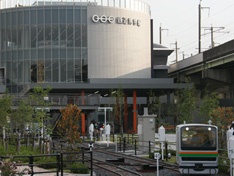
Based on the concepts of railways, history and education, the museum is comprised primarily of the History Zone, which relates the role and influence of railways in Japan centered primarily in an exhibit of actual railway rolling stock and the Education Zone, where visitors can learn about railway principles and mechanisms as well as the most up-to-date railway technology through hands-on experience while using models, simulation, play equipment, etc.

Skyline of Saitama Shintoshin
Watch Horgalåten at the music festival at Saitama city video here
Sendai Famous Nightlife in Kokubu Cho 3 Dec 2009 12:59 AM (15 years ago)
Sendai (仙台市) is the capital city of Miyagi Prefecture, and the largest city (about 1,000,000 people) in the Tohoku region of Japan's Honshu island. Although Sendai is a large city, it is known throughout Japan as a modern city which is in harmony with nature. The city possesses beautiful scenery, such as the Hirose-gawa River that runs through central Sendai, and the lush Zelkova trees that line the central city. Greenery is especially abundant in the center of the city, which has tree-lined streets and parks. As a result, Sendai is called the “City of Trees.”
While Sendai is not quite as old as Tokyo or Osaka, is has quite a long history. Sendai’s numerous zelkova trees have earned it the nickname ‘City of Trees’. Although Sendai was nearly completely demolished during World War II, the city completely recovered, and sports a friendly, relaxed small-town atmosphere. You can find everything in Sendai, from airy streets to amazing glass skyscrapers and bustling shopping districts.
Less than an hour northeast of the city center lies the town of Matsushima, whose bay is dotted by pine clad islets and is known for one of Japan's three most scenic views.
Sendai is located approximately 300 kilometers (180 miles) north of Tokyo on the Pacific coast of Honshu (the largest of Japan's four major islands). Sendai lies in the center of the Tohoku (northeast) Region, one of the seven major regions in Japan.
Sendai Tourism
Sendai is not a tourist city, as its suffered from World War II and rebuilt after. Most popular tourist sightseeing is a castle and museum. The ruins of Sendai Castle are located close to downtown on Aobayama, which also gives a panoramic view of the city. The Zuihoden Mausoleum is the tomb of Date Masamune, and is also home to artifacts related to the Date family. It is located on a hill called Kyogamine, which is the traditional resting place for members of the Date family. The Ōsaki Hachiman Shrine, built in 1607 by Date Masamune, is designated as a national treasure.
Some of recommended sightseeing in Sendai, in short such as : Sendai City Museum; Masamune's mausoleum; Castle ruins, Jozenji street – lined with sculptures, good base to visit scenic island-dotted bay at Matsushima on the coast and Zao Onsen in the mountains. Both offer hot-springs & great views. Miyagi Stadium.
Sendai is a modern city in harmony with nature. The city is surrounded by a splendid natural environment, from the western Ohu Mountains to the eastern Pacific Ocean. Therefore, tourist can visit some sites that related to nature.
Nature Sightseeing in Sendai :
1. Matsushima Bay, dotted with many islands covered with pine trees, is located approximately 30 km from Sendai. It is known as one of Japan’s three most scenic locations. Matsushima is a haven from the Pacific Ocean’s harsh waves and is also famous for its oyster farming.
2. The Zao Mountains. A one-hour drive from Sendai takes you to Mt. Zao, a collection of several age-old volcanoes. Near its summit, you can enjoy a pleasant walk around the Okama, a crater lake known for its ephemeral colors. Mt. Zao is also famous for the snow monsters (frost covered trees) that can be seen during the winter.
3. Hot Springs. Akiu and Sakunami are both hot spring resorts near downtown Sendai. A 30-minute drive takes you to these resorts, which boast many hotels and traditional Japanese inns (ryokan) that offer comfortable big baths among the beauty and tranquility of the mountains.
Museuma and Castle in Sendai :
1. Zuiho-den (Tel: 022 262 6250) is the mausoleum of Matsuname Date (known as the "one-eyed dragon") and reminiscent of the Tokugawa mausoleum in Nikko. The original, ornate 17th century buildings were destroyed in World War II but completely restored in 1979. Set at the top of a flight of steep stone steps within a forest, the site also includes the mausoleums of Date Tadamune and Date Tsunamune, the second and third successors of the clan father Matsuname.
2. Sendai Castle aka Aoba-jo dated from 1602 but nothing remains today of the buildings except for the impressive stone walls and a reconstructed turret. The castle grounds do have fine views of the city and an iconic statue of Matsuname on horseback. The Aoba Castle Exhibition Hall (Tel: 022 222 0218) has computer-generated displays of what the castle looked like in its glory days.
3. The Sendai City Museum (Tel: 022 225 3074) introduces the history of the city and displays of Date family treasures including Matuname's suit of armor and relics from the fascinating journey to Mexico and Europe by Matsuname's retainer Hasekura Tsunenaga (1613 - 1620). This epic voyage, Japan's first embassy to the Americas and Europe, is described in Shusako Endo's novel The Samurai.
4. Other museums in Sendai include the Miyagi Museum of Art (Tel: 022 221 2111) and Tohoku University's Museum of Natural History (Tel: 022 795 6767). Of the temples and shrines in the city, Osaki Hachimangu Shrine (Tel: 022 234 3606) dates from 1607 and is a good example of Momoyama Period architecture. The shrine houses the guardian deity of the Date family and is the site of the Donto fire festival in January. Nearby Rinnoji Temple has a Japanese-style garden noted for its irises in June.
5. Sendai Mediatheque (Tel: 022 713 4483) is a modern art and film center on Jozenji Dori. Besides its library, Mediatheque hosts exhibitions, film screenings and workshops.
Tanabata Festival
The Tanabata-matsuri Festival, held every summer in Sendai, is considered one of the four greatest festivals in the Tohoku region. It is one of the most popular attractions, drawing crowds of over 2 million spectators every year. The festival is based on the Chinese seventh of July legend: The 'Kengyu' (a cowherd) represented by the star Altair, and the 'Orihime' (a weaver) represented by the star Vega, appear on either side of the Milky Way and cross the bridge of magpie's wings over the Milky Way for their one-time rendezvous a year.
Sendai Nightlife
Sendai nightlife is full of drink and eating places. Don't miss the Kokubu-cho area, the designated entertainment district where you can find everything from small izakayas to large nightclubs and classy bars. Club Shaft is a large mainstream venue where Sendai’s youngsters gather to drink every possible kind of beer in the world and dance the night away to DJ music.
Chuo Dori, also called Clis Road, is mainly a huge shopping district, but with a fair share of clubs and bars catering to students.
Vilevan near Sendai Station is a great place for jazz lovers and for those who would rather chill out and have a couple of quality drinks than show off their dance moves. Ernie’s Bar is the perfect place to meet fellow travelers or expats with whom you can swap stories.
Recommended bars in Sendai :
1. Bar,isn't it?
Address : 3-9-13,Ichibancho,Aoba-ku,Sendai
2. CLUB SHAFT
Address : 2-10-11,Kokubuncho,Aoba-ku,Sendai
3. Gastro-Pub COOPERS
Address : 2-1-3,Kokubuncho,Aoba-ku,Sendai
4. Finger Foods Bar PINE
Address : 1-8-21,Chuo,Aoba-ku,Sendai
Sendai Photos and pictures :

Sendai Ichibancho Arcade. This covered mall connects several streets together in the downtown area to create the largest arcade in the Tohoku region. The shopping area includes several different arcade malls and covers a T-shaped area along Ichibancho and Chuo dori.

Sendai Kokubu Cho Nightlife

The most famous festival in Sendai is the Sendai Tanabata Festival, which attracts more than 2 million visitors every year and is the largest Tanabata Festival in Japan.

Matsushima is famous for its bay, which is dotted by many pine clad islets and has been ranked one of Japan's three most scenic views for centuries. The small town is also known for Zuiganji, one of the Tohoku Region's most important Zen temples.

The Zao Mountains, a one-hour drive from Sendai takes you to Mt. Zao, a collection of several age-old volcanoes.
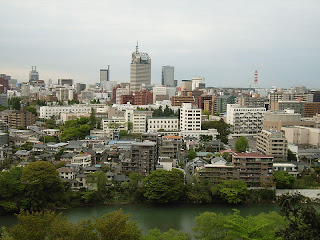
Downtown Sendai from the nearby Atago shrine

Sendai Kokubuncho at night, it has more than 3000 bars and restaurants assembled, and the busiest entertainment area in all of northeastern Japan.

Southeast entrance from Sun Mall Ichibancho.

The night match at the Sendai stadium
Watch Sendai City and shopping sightseeing video here :
Otaru Sapporo City with Canal Area 19 Nov 2009 8:04 PM (15 years ago)

Otaru main attraction is its charming canal district. Its a variety of Western-style from the late Meiji period buildings made the Japanese dub Otaru the "Romantic city". Have a look at the Mitsui Bank, former Nippon Yusen Kaisha (NYK) building, Music Box Museum, among others.
Otaru's nickname is "the town of hills" as there are so many hills, including Jigoku-zaka (hell hill) - a very steep slope, and the long, winding Funami-zaka. Mt. Tengu-yama that towers behind Otaru is a popular ski resort in winter. There is an observation point on Mt. Tengu-yama, and the panoramic view including the whole of Otaru and its port area is absolutely wonderful. There are also cable cars to take you to the mountaintop.
Otaru is a nostalgic town, old-fashioned mood is enhanced by its architecture and layout. A beautiful large canal flows through it. You also find the old remnant of the major industry of Otaru, many glass-ware shops. As they used to make a lot of glass buoys, lamps for fishery, they had many glass-ware factories, where they’ve come to make various kinds of products to attract the visitors as days went by
Otaru Main Attractions :
1. Canal Area. Beautiful canal lined by old warehouses.
2. Herring Mansion. A wealthy fisherman's former mansion.
3. City Museum. Museum about the history of Otaru.
How to get Otaru :
By ferry
Otaru is one of Hokkaido's key ferry ports, and the closest to Sapporo. Shin-Nihonkai Ferry (06-6348-1120) operates a daily service between Sapporo and Niigata (18 hours, ¥6,200+) and between Sapporo and Maizuru near Kyoto (20 hours, ¥9,600+). Both services are overnight, and private cabins are available for a higher fare (the base fare buys sleeping space on the floor).
By Train
Otaru is about 30 minutes from Sapporo and 75 minutes from Chitose Airport using the "JR Rapid Aiport" (¥620 and ¥1,740, respectively).
Between Shin-Chitose A.P. and Sapporo, take either JR or bus. For information, the page [Access between the airport and Sapporo] is helpful.
Fares can differ depending on the occasion. Discount tickets can be available.
From Sapporo to Otaru, it’s about 38.9km, from New Chitose Airport, about 81.9km. These 3 places are lined to one another making almost straight line, making it quite easy to enjoy one-day tour including a few hours’ stay in Otaru.
For the transportation from Otaru ~ Sapporo ~ New Chitose Airport, discount ticket by JR ?One day Walk Ticket?( Ichinichi- Sampo-Kippu )( 2,040 yen ) is convenient and cheaper ( by 320 yen ).
From Sapporo to New Chitose Airport
By Airport-Express( run every 15 min.), about 35 min. 1040 yen.
From Sapporo to Otaru
By express train ( run every 30 min. ) about 30 min. 620 yen.
By Bus
From Bus Terminal, Sapporo Station, run about every 10 min.(weekday) about 55 min., 590 yen.
By rent-a -car
Drive through express, about 39km, 45 min. 1,200 yen ( toll ) besides rental of the car.
By Taxi
From JR Sapporo Sta. to Otaru downtown including the express toll, from about 9,000 to 13,000 yen, about 50 min..
For the round trip from Sapporo to Otaru, including about 3 hours’ sight-seeing in Otaru, from about 27,000 to 35,000 yen.
Otaru Nightlife
There really isn't much in the way of nightlife in Otaru. If you want to rave, jump on a train and head into Susukino in Sapporo. FInd the Gaijin Bar and kick back.
Photos of Otaru, Hokkaido, Japan.
Otaru is a small city and has an estimated population of 137,693 and the density of 580.11 persons per km².

The Herring Mansion stands 6 kilometers outside the city, just next to the Otaru Aquarium. From Otaru Station, buses take about 30 minutes and cost 200 yen.
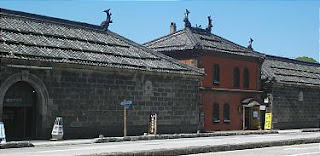
Otaru City Museum stands next to Otaru Canal, a 5-10 minute walk straight down the main road from Otaru Station.
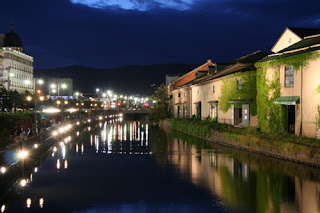
The canal was completed in 1923. The canal has been developed as a walkway. It is lit at night by gas lamps and walkway lights. Located 10 minutes walk from Otaru Station

From Sapporo to Otaru, it’s about 38.9km, from New Chitose Airport, about 81.9km. These 3 places are lined to one another making almost straight line, making it quite easy to enjoy one-day tour including a few hours’ stay in Otaru.
Akihabara Tokyo Electronic Gadget Shopping 9 Nov 2009 2:16 AM (15 years ago)
 Akihabara (秋葉原) ("Field of Autumn Leaves"), also known as Akihabara Electric Town (秋葉原電気街 Akihabara Denki Gai), is an area of Tokyo, Japan. What make Akihara so famous is AKihabara or Akiba is the central of Electronic shops in Japan.
Akihabara (秋葉原) ("Field of Autumn Leaves"), also known as Akihabara Electric Town (秋葉原電気街 Akihabara Denki Gai), is an area of Tokyo, Japan. What make Akihara so famous is AKihabara or Akiba is the central of Electronic shops in Japan.
Akihabara is the biggest electronics shop district in the world and one of the most important Japanese pop culture springs. Akihabara dreamed place for gadget, technology, anime, video games, robots and manga lovers.
Akihabara is the otaku of those who interested in Cosplay, Anime, Manga, and video playings. We can see the latest fashion in Japanese Electronic goods.
Major stores in Akihabara :
1. Ishimaru Denki
Operating ten stores across Akihabara, including the Main Store, Number One branch and Ekimae branch for electronic equipment, the Pasokon branch for PCs and the Game One and Soft One to Three branches for CDs, DVDs, games and anime related goods
2. Sofmap
Sofmap operates as many as 16 shops in the Akihabara area including multiple branches, which specialize in used computers. The stores are numbered from 1 to 14 plus the main store and the Kakuta branch. A duty free floor can be found in store number one.
3. Laox
Operating eight stores in Akihabara, including the Main Store, Computer branch, Duty Free Akihabara branch and Watch & Camera Branch, the Gakkikan branch for music instruments and three Asobit City branches for hobby and game related products.
4. Yamada Denki - Labi Akihabara
Yamada Denki operates a "LABI" store just across the street from the Akihabara Electric Town exit of JR Akihabara Station. It specializes in personal computers, pc accessories, and household electronics.
5. Akky
Akky operates three duty free shops in the area around Akihabara Station: Akky Main Store, Akky II and Akky III. Products on sale include a variety of electronic equipment for overseas use, including cameras, computers, televisions, DVD players and software.
6. Yodobashi Camera
The Shinjuku based discount electronic store giant Yodobashi Camera opened its huge Akihabara branch in September 2005. Unlike most other electronic shops, it is located on the east side of Akihabara Station, in the new Yodobashi Akiba Building.



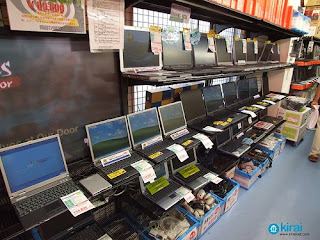


New Chitose Airport Airlines in Hokkaido 31 Oct 2009 8:21 PM (15 years ago)
 Chitose (千歳市 Chitose-shi) is a city near Ishikari, Hokkaidō, Japan. Chitose now famous as it has a new airport "New Chitose Airport" the biggest international airport in Hokkaidō and closest airport to Sapporo, as well as the neighboring Chitose Air Base. The city is bounded by Eniwa in the north and by Tomakomai in the south.
Chitose (千歳市 Chitose-shi) is a city near Ishikari, Hokkaidō, Japan. Chitose now famous as it has a new airport "New Chitose Airport" the biggest international airport in Hokkaidō and closest airport to Sapporo, as well as the neighboring Chitose Air Base. The city is bounded by Eniwa in the north and by Tomakomai in the south.
Chitose located in the mid-western part of Hokkaido, adjacent to 3 cities, 5 towns and 1 village. The city stretches lengthwise east to west. The mountainous western part encompasses the Shikotsu portion of Shikotsu-Toya National Park, while the flat central part of the city contains the downtown and airport areas. To the east are hills utilized for agriculture and forestry.
New Chitose Airport (新千歳空港 Shin-Chitose Kuko) is an airport in Chitose, Japan near Sapporo. It has the IATA Airport Code CTS.
On July 24, 1999, All Nippon Airways Flight 61, which was flying from Tokyo International Airport in Tokyo, Japan to Chitose, was hijacked shortly after takeoff. The hijacker killed the pilot before he was subdued. The Boeing 747 landed safely.
The following airlines fly to New Chitose Airport:
Air Do Hokkaido International Airlines
Air Nippon
All Nippon Airlines
All Nippon Airways
China Northern Airlines
Continental Micronesia
Hokkaido Air System
J-Air
JALWays
Japan Airlines
Japan Airlines Express
Japan Air System
Korean Air
How to access New Chitose Airport
By Rail
New Chitose Airport Station is located on a spur off the Chitose Line of Hokkaido Railway Company (JR Hokkaido). Rapid service trains operate to and from Sapporo Station, taking 36–39 minutes and costing ¥1,040.
By Bus
Hokkaidō Chūō Bus/Hokuto Kotsu joint service (Sapporo 4 trips/hr., Oyachi 4 trips/hr.)
Hokkaidō Chūō Bus (Asabu 1–2 trips/hr., Miyanosawa 1–2 trips/hr.)
Hokuto Kotsu (Apa Hotel & Resort 2 trips/hr., Maruyama Park hourly)
Donan Bus (Tomakomai 1–2 trips/hr., Noboribetsu 3 trips/day, Muroran 12 trips/day, Hobetsu 2 trips/day, Urakawa 2 trips/day)
Atsuma Bus (Atsuma 3 trips/day)
New Chitose Airport (CTS) Information :
Address: New Chitose Airport, Chitose, Hokkaido 066-0012
Tel: (0)123 23 0111
The airport for Sapporo, on Hokkaido, north Japan.
The airport has a clinic/chemist, a Foreign Exchange counter, a branch of Hokuyo bank, cash machines and a Post Office.
Transportation: Japan Railways (JR) operates Airport Express trains to and from Sapporo Station, taking around 36 minutes and costing ¥1,040. In addition, there are various bus services to skiing areas of Hokkaido.
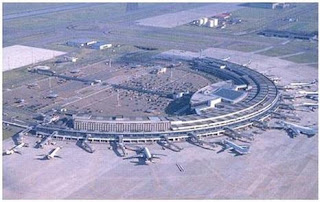
New Chitose Airport is an airport located 2.7 NM (5.0 km; 3.1 mi) south southeast of Chitose and Tomakomai, Hokkaidō, Japan

New Chitose Airport is the biggest international airport in Hokkaidō and closest airport to Sapporo, as well as the neighboring Chitose Air Base
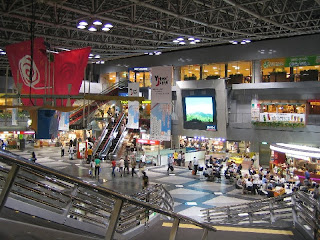
Terminal Building in New Chitose Airport
New Chitose Airport Map and Location

Japan Airlines and Air Nippon Airlines in New Chitose Airport
Lake Kawaguchi Popular lake Mount Fuji 22 Oct 2009 4:10 AM (15 years ago)
 Lake Kawaguchi (河口湖 Kawaguchi-ko) is one of five Lakes that near Mount Fuji, located in Fujikawaguchiko, Yamanashi. Lake Kawaguchi (Kawaguchiko), is the most easily accessible of the five lakes, is located just next to Fuji-Yoshida in neighboring Fuji-Kawaguchiko Town. The other four lakes are Lake Motosu (本栖湖), West Lake (西湖), Lake Shoji (精進湖), Lake Yamanaka(山中湖) ~ The latter three are less developed than Lake Kawaguchi, but more difficult to access.
Lake Kawaguchi (河口湖 Kawaguchi-ko) is one of five Lakes that near Mount Fuji, located in Fujikawaguchiko, Yamanashi. Lake Kawaguchi (Kawaguchiko), is the most easily accessible of the five lakes, is located just next to Fuji-Yoshida in neighboring Fuji-Kawaguchiko Town. The other four lakes are Lake Motosu (本栖湖), West Lake (西湖), Lake Shoji (精進湖), Lake Yamanaka(山中湖) ~ The latter three are less developed than Lake Kawaguchi, but more difficult to access.
Lake Kawaguchi is the oldest of the five and it is at least 50-60 thousand years old. There are scores of underwater springs at the lake bottom. There is no discernible surface flow into or out of the lake. Major flows of water appear to take place underground.
Lake Kawaguchi is also a popular tourist destination. A tour to Mount Fuji usually packaged with visiting Lake Kawaguchi. The number of visitors to the five-lake area exceeds ten million annually. Lake Kawaguchi, directly linked to Tokyo Metropolitan urban districts through a major artery highway and closest to the terminal of the Fuji Subaru scenic route, is a centre of tourist attraction in this area.
Lake Kawaguchiko is the most famous of the five lakes for vacation. A large number of hotels line its banks, as do locals providing boat rides to the tourists. Also, there is one of the most famous amusement parks, Fujikyu Highland which is featuring one of the world's highest roller coasters. Many local cultural events are run near this lake throughout the year. Especially, Kawaguchiko firework is the major even for the summer.
Last but not least, Kawaguchiko is home to the amusement park Fuji Q High Land, featuring one of the world's tallest roller coasters and other thrilling attractions with Mount Fuji as backdrop.
How to access Lake Kawaguchi
Kawaguchiko Station is the terminal station of the Fuji Kyuko Railway Line from Otsuki. The bus terminal for local buses and highway buses to/from Tokyo, Kofu, Gotemba and other destinations is located just in front of the station.
From Kawaguchiko Station, two "Retro Bus" lines provide local transportation around Lake Kawaguchiko and Lake Sai: The shorter "Kawaguchiko Line" operates along Lake Kawaguchi's eastern and northeastern shores (about 2 buses/hour), while the "Saiko-Aokigahara Line" operates along the Lake Kawaguchi's southern shores and further connects to Lake Sai (about 1 bus/hour).
How to access Mount Fuji Area
Fujigoko (富士五湖)
Terminal Station: Fujikyuko Kawaguchiko (河口湖)
Access from Tokyo By Train :
1. From Tokyo station.
2. use Chuou (JR) line to Otuki station (2 hr.)
3. use Fuji Express to Kawaguchiko (53 min.)
Access from Tokyo By Car :
1. Use Chuo Expressway to Kawaguchiko (2 hr.)
Mount Fuji and Lake Kawaguchi Photos and infos :

Lake Kawaguchi (Kawaguchiko) is the most easily accessible of the Fuji Five Lakes. It is located in Kawaguchiko Town, a hot spring resort named after the lake, and well connected with central Tokyo by trains and direct buses.

Mt Fuji and Lake Kawaguchi in autumn, Kawaguchiko town, Yamanashi prefecture, Japan
Kawaguchi town and Fuji from the station Chris Moore, 2005

Kawaguchiko / Kawaguchi Lake view from the top
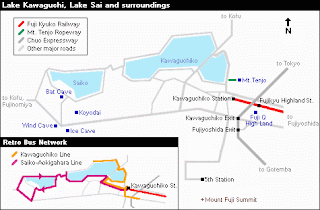
Lake Kawaguchi, Lake Sai and surroundings Map including the retro bus route

Among the local food specialties are Hoto Noodles, a rustic noodle soup dish garnished with vegetables.

We travelled to Kawaguchi lake from Kawaguchiko train station by Retrobus. My Kawaguchiko Saiko Free Kippu already included 2 days Retrobus, hence I only bought the boat and ropeway pass at 1200 yen.
Asahikawa Japan Hokkaido Ski resort 5 Oct 2009 8:58 PM (15 years ago)
 Asahikawa (旭川市), is a second largest city on the northern island of Hokkaido, Japan after Sapporo. The city is currently well-known for the Asahiyama Zoo and Asahikawa Ramen.
Asahikawa (旭川市), is a second largest city on the northern island of Hokkaido, Japan after Sapporo. The city is currently well-known for the Asahiyama Zoo and Asahikawa Ramen.
Asahikawa city is full of natural splendor, with the magnificent Mt. Daisetsu-zan in the background and 120 rivers flowing through it. It is also the gateway for tourism to Soun Gorge and the Furano area. Asahikawa's thriving art world has led it to be called a town for art. Fountains and sculptures dot the shopping park along Heiwa-dori Avenue, the road that leads straight from Asahikawa Station.
Asahikawa Tourist Destination
Although Asahikawa is a small city by Japanese Standards, the city is an excellent base for ski trips to the numerous ski holiday resorts that surround Asahikawa. Additionally Asahikawa has an airport offering connecting flights with the main Japanese hubs.
There are numerous bars and restaurants and the city boasts some great features including a nationally famous zoo and several museums including a Sake museum where tasting is possible. Asahikawa is ringed by ski resorts and transfers via public or private transport to them are easily possible. Asahikawa offers access to a variety of resorts rather than immediate access to any. Asahikawa also has great and authentic Japanese nightlife.
Some of Asahikawa City Tourist must see and destinations :
1. Ginza Shopping Street Nakamise Dori
This area is nicknamed the “kitchen of Asahikawa”, and is always crowded with people doing their shopping in the local stores and market.
Address: 1~4 Jo, 14~15 Chome, Asahikawa
2. San-roku
San-roku (literally three-six) is the central part of the city, and is the hotspot of Asahikawa nightlife. There are over 1,300 different bars, clubs, restaurants, karaoke bars, and cafes.
Address: Around 3 Jo 6 Chome, Asahikawa
3. Hokkaido Traditional Art Craft Village
This world-class group of museums and galleries are situated just outside Asahikawa city. The view of the town from outside the buildings is as beautiful as the buildings themselves! The village comprises of the Yukara textile art center, the international Dyeing museum and the Snow museum. The unique items on display in village cannot be seen anywhere else in the world, making it one of the best tourist attractions in Hokkaido!
Address: Minamigaoka 3 Chome, Asahikawa
Tel: 0166-62-8811
4. Asahikawa City Museum (Asahikawa City Taisetsu Crystal Hall)
The museum is part of the Crystal hall complex, and contains interesting displays about nature in the Taisetsu region and the history of Asahikawa.
Address: Kagura 3 Jo 7 Chome
Tel: 0166-69-2004
5. Asahikawa City Asahiyama Zoo
Zoo in the Japanese north that opened in 1967. The exhibition method (action exhibition) by which ecology animal original can be observed more naturally by a near appearance wins popularity, and attention is attracted from nationwide various places.
Address: Kuranuma, Higashi Asahikawa-cho
Tel: 0166-36-1104
6. Asahikawa Ramen Village
Located very close to JR Nagayama station, the ramen village hosts 8 of Asahikawa’s finest ramen shops. The village is open all year round, and ramen products are available from the souvenir shop within the building complex.
Address: Powers shopping area, Nagayama 11 Jo 4 Chome
Tel: 0166-48-2153
7. Santa Present Park
This “World of Santa Claus” has an amusement area for children and popular ski ground during the wintertime. There is also an observatory tower from which Asahikawa city and the Mt. Taisetsu mountain range can be seen.
Address: Kamui-cho, Tomioka 2 555 Banchi
Tel: 0166-63-3232
8. Kamui Park Grove
This park is very popular with families during the summertime, as there are both indoor and outdoor sports facilities, along with a large space for camping and barbequing.
Address: Kamui-cho, Tomisawa
Tel: 0166-63-4045
9. Stalhin Stadium
Asahikawa’s only stadium is named after the famous baseball pitcher “Stalhin”. The baseball stadium has many professional and amateur baseball games and other events during the summertime, and in the wintertime the grounds are converted to a children’s skiing field.
Address: Hanasaki-cho, 2~3 Chome
Tel: 0166-51-7591
10. Hanasaki Sports Park
The sports park has a wide range of sports facilities, including the Stalhin baseball stadium, running track, tennis and basketball courts, an archery field, and an outdoor Olympic size swimming pool.
Address: Hanasaki-cho, 1~5 Chome
Tel: 0166-52-1934
11. Clark Horse Stables
Located near Asahiyama zoo, you can try your hand at western style horse riding. Horse trekking courses are available and are very popular with beginners who want to try horse riding for the first time.
Address: Sakuraoka 160-4, Higashi Asahikawa-cho
Tel: 0166-36-5963
12. Ski Areas
Hokkaido is a snow lover’s paradise. There are many different ski areas in Asahikawa, 5 within the city limits and another 9 in the surrounding areas. Each ski slope has it’s own unique set of courses, but they all share the same high quality powder snow.
Address: Various locations in and around the city
13. Golf Courses
Asahikawa is a dream location for golf fans, as it has a wide variety of magnificent mountain courses just a short drive away from the city.
Address: Various locations in and around the city
14. Campsites
There are a large number of campsites dotted in and around the city and surrounding areas. You can choose from locations near to rivers, forests, or mountains.
Address: Various locations in and around the district.

Asahikawa Kaimono Koen. Asahikawa's Shopping District Park is located in front of the JR Station and runs perpendicular to it. It is a pedestrian only mall and there are shops and restaurants on both sides.

Ginza Shopping St. Nakamise Do-ri (15-chome market)
It is called a kitchen of the people in Asahikawa. As good and old trace and warm hearted atmosphere, it is familiar to a lot of citizens.

Heiwa Street in Asahikawa

Asahikawa Winter Festival 2009 all snow - 50th anniversary (Snowman Castle and Nagoya Castle)

Asahikawa Grand Hotel. From Asahikawa Airport: 40 mins. by bus or 30 mins. by taxi. From JR Asahikawa Station: 4 mins. by taxi or 10 mins. on foot

Asahikawa bus terminal(Hokkaido Chuo Bus)
Furano Hokkaido Japan Ski Holiday 11 Aug 2009 8:31 AM (15 years ago)

Furano Skiing
Furano is famous for winter holiday destination because of its ski slopes.
Furano ski resort has two great ski areas: Furano and Kitanomine. Both areas are interconnected by the lifts and boast over 900 vertical meters of terrain suitable for all abilities and will challenge even expert skiers. It is one of the most respected ski areas in the whole of Japan and with an average seasonal snowfall of over 8 metres; the perfect destination.
The Furano ski resort lies at the very centre of Hokkaido and is reknowned for its long runs, magnificent views and the ever present Hokkaido powder, with falls of up to 8 metres per season on average. Furano resort has been the venue for world cup races with many of the world's great skiers having tested its steep and fast ski runs.
Ski area lifts include the 6 person Kitanomine Gondola which goes 2.95km giving runs up to 4.5 km in length, the 100 person Furano Ropeway which covers 2.5km in 5 minutes! The central valleys have superb powder and the views of the central ranges of Hokkaido are spectacular. Furano is well known for it’s lack of crowds adding to your enjoyment of this former world cup resort. There are ample beginner/intermediate runs at the base of each side of the mountain, with the steeper and deeper runs up high.
Furano Sightseeing
Sightseeing in Furano can be seperated into several locations such as : Biei, Kami Furano, Naka Furano, Furano, Minami Furano, and Shimukappu.
Some of Furano Sightseeing spots and main attractions are listed here :
1. Chushin-Hyou Park.
The hear of Hokkaido LIes in a corner of Furano Elementary School Yard. 1.2km form JR station
2. Furano Winery
The winery produces dozens of varieties of local wine carefully developed mellow flavor and scent. Observation tour and tasting are available.
Tel: 0167-22-3242. 3km from JR station
3. Furano Grape Juice Factory
100% Fruit juice tastes great. Furano Grape Juice comes in red or white. Observation tours and tasting are available.
Tel: 0167-23-3033. 4km from JR station
4. Furano Cheese Factory
The factory manufactures and sells Furano cheese and Furano Milk. Cheese tasting is available. The adjoining Ice Milk Factory is always crowded. You can try your hand at a number of things, including making butter and ice cream, at The Hands-on Work Shop. (Booking necessary)
Tel: 0167-23-1156. 4km from JR station
5. Taiyo-no-Sato Park Fureai House
This 20ha.-park includes camping site, adventure circuit and a park golf course. At Fureai House, you will find a restaurant and accommodation.
Tel: 0167-42-3445. 14km from JR station
6. Hotel Furano HIghland's lavender fields
You can take a look at the largest lavender fields in the city from its outdoor hot spring.
Tel: 0167-22-5700. 7.5km form JR station
7. Furano Ski Resort
This international class ski resort has hosted the World Cup Skiing Competition 10times and the World Cup Snowboarding Competition. The resort offers slopes for all levels of skiers. Snowboarders are also welcomed. The ropeway can hold up to 101 passengers and it the fastest of its kind in Japan. It also operates in the off-season.
Tel:0167-22-1111. 2.7km from JR station
8. Ningle Terrace
A shopping road of log houses designed by Soh Kuramoto. Nearby to this spot are the cafe Morino-Tokei (A Clock in a Forest), featured in the TV drama "Yasahii Jikan" (Heart Warming Moment) and "Soh's Bar" also designed by Soh Kuramoto.
Tel:0167-22-1111. 7km form JR station
9. Rokugo-no-Mori, the Forest
The family of Goro Kuroita, the leading character appeared in the TV drama "Kitano Kuni Kara" (From the North Country) lived in this forest.
Tel:0167-29-2323. 18.2km form JR station
10. Goro's Stone House
A spot commonly used as the main set in "Sudachi, Leaving the Nest", a chapter from the TV drama "Kitano Kuni Kara". 21km form JR station
11. Jun and Yui's Recycled House
A popular location used as the set for the TV drama "Kitano Kuni Kara" where you can see unique ideas shown in the Recycled Houses. 16.5km from JR station
12. Kitano Kuni Kara Siryoukan, the Museum
This museum contains commemorative items and information for "Kitano Kuni Kara", and was built under the supervision of the author, Soh Kuramoto.
Tel:0167-39-2800 0.3km form JR station
Furano Sightseeing and Ski photos and pictures :
The Furano ski resort lies at the very centre of Hokkaido and is reknowned for its long runs, magnificent views and the ever present Hokkaido powder, with falls of up to 8 metres per season on average.

Furano and Biei are two towns in the center of Hokkaido, known for their pleasant and picturesque rural landscapes.

New Furano Prince Hotel, Furano, Hokkaido

Hotel in Furano Japan

Farm Fomita in Naka Furano Many lavender fields are in bloom.

Furano Ski Area Map
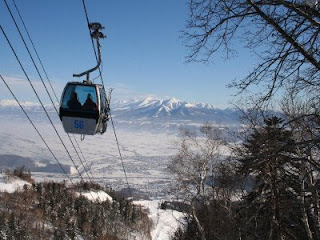
Cable Car to Furano Ski Resort






